Singerstraße 27
Dark Glasses
Lena Henke
April 11 – May 18, 2024

Lena Henke
Dark Glasses, 2024
Installation view
Layr Singerstraße, Vienna
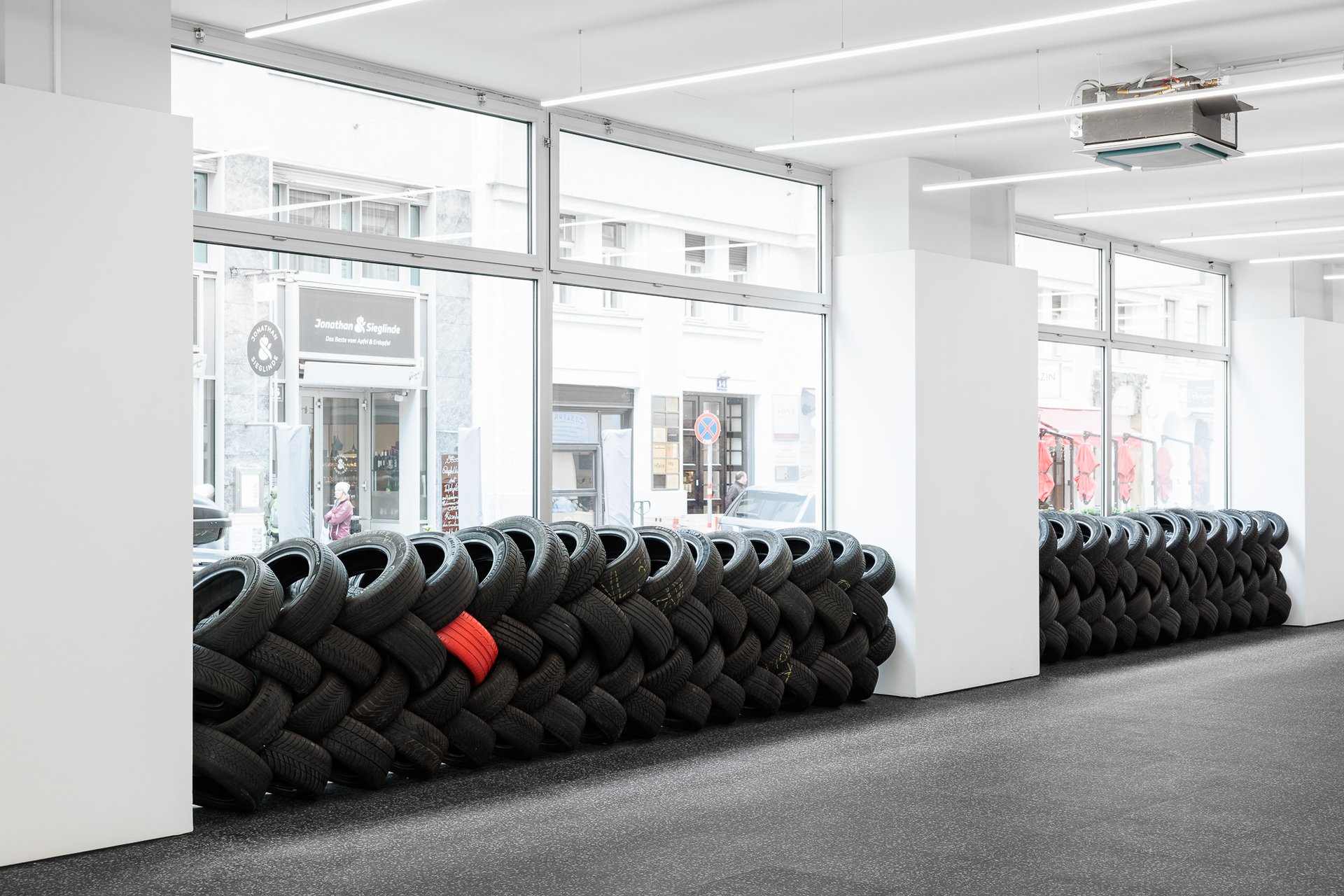
Lena Henke
Dark Glasses, 2024
Installation view
Layr Singerstraße, Vienna
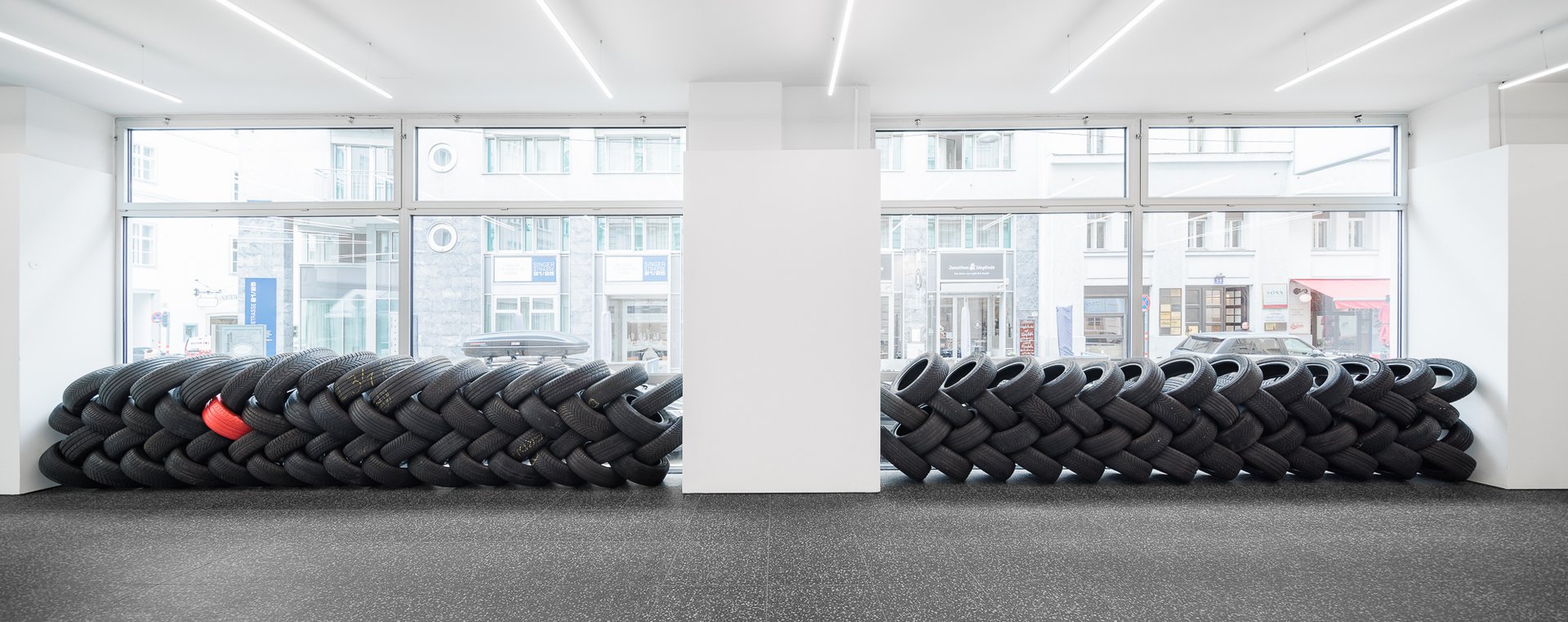
Lena Henke
Dark Glasses, 2024
Installation view
Layr Singerstraße, Vienna
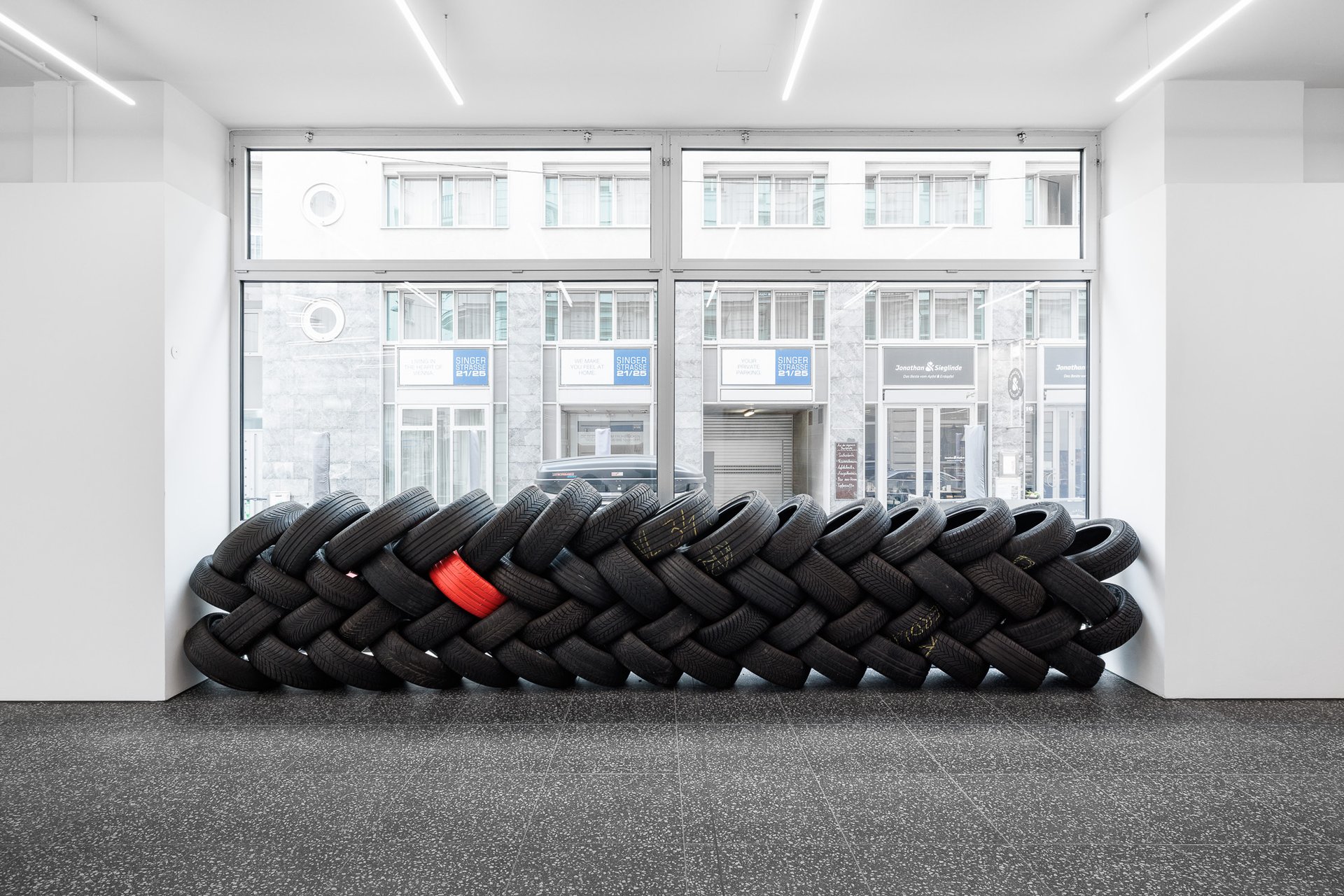
Lena Henke
A hard shoulder I, 2024
Car tires
dimensions variable
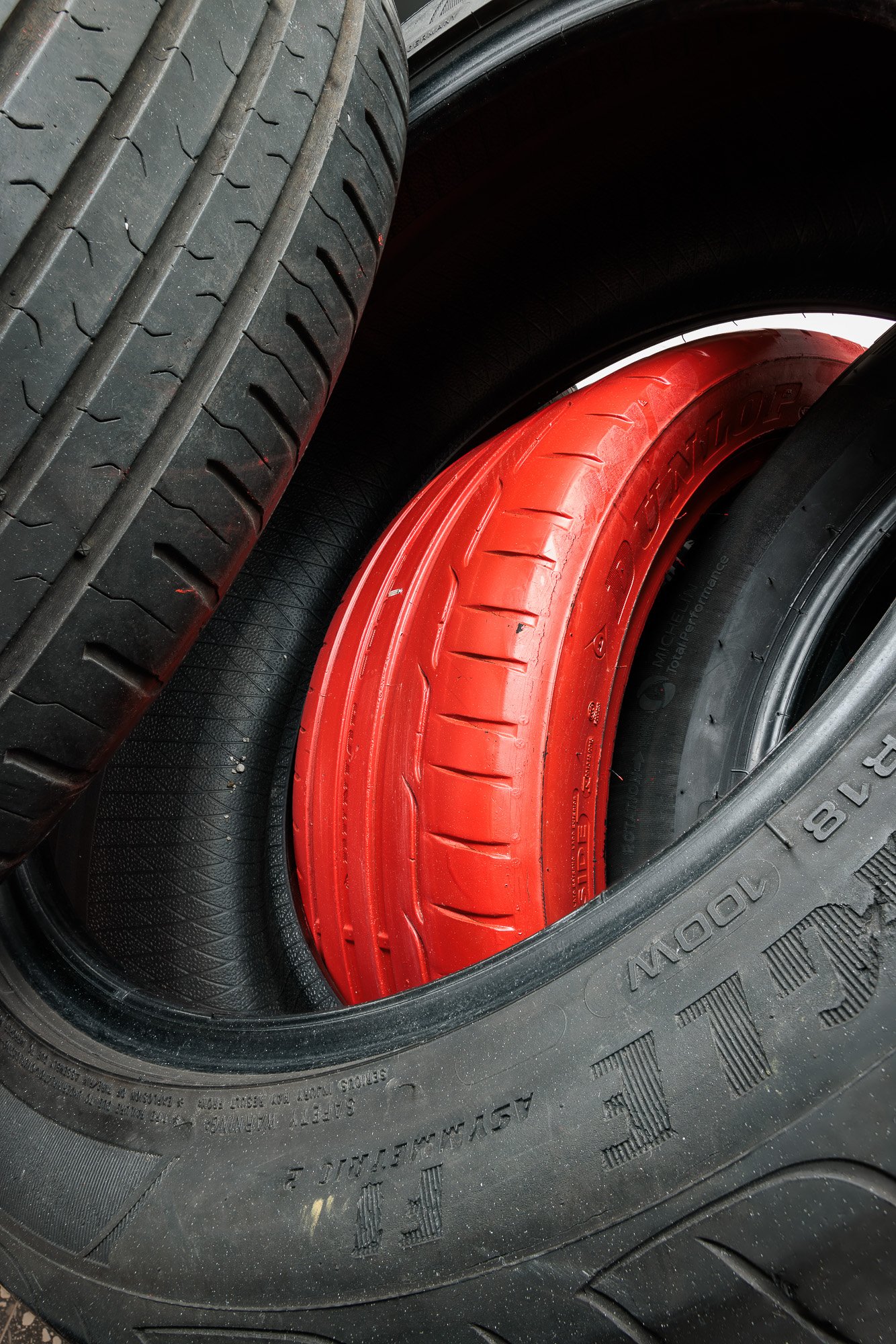
Lena Henke
A hard shoulder I, 2024
Car tires
dimensions variable
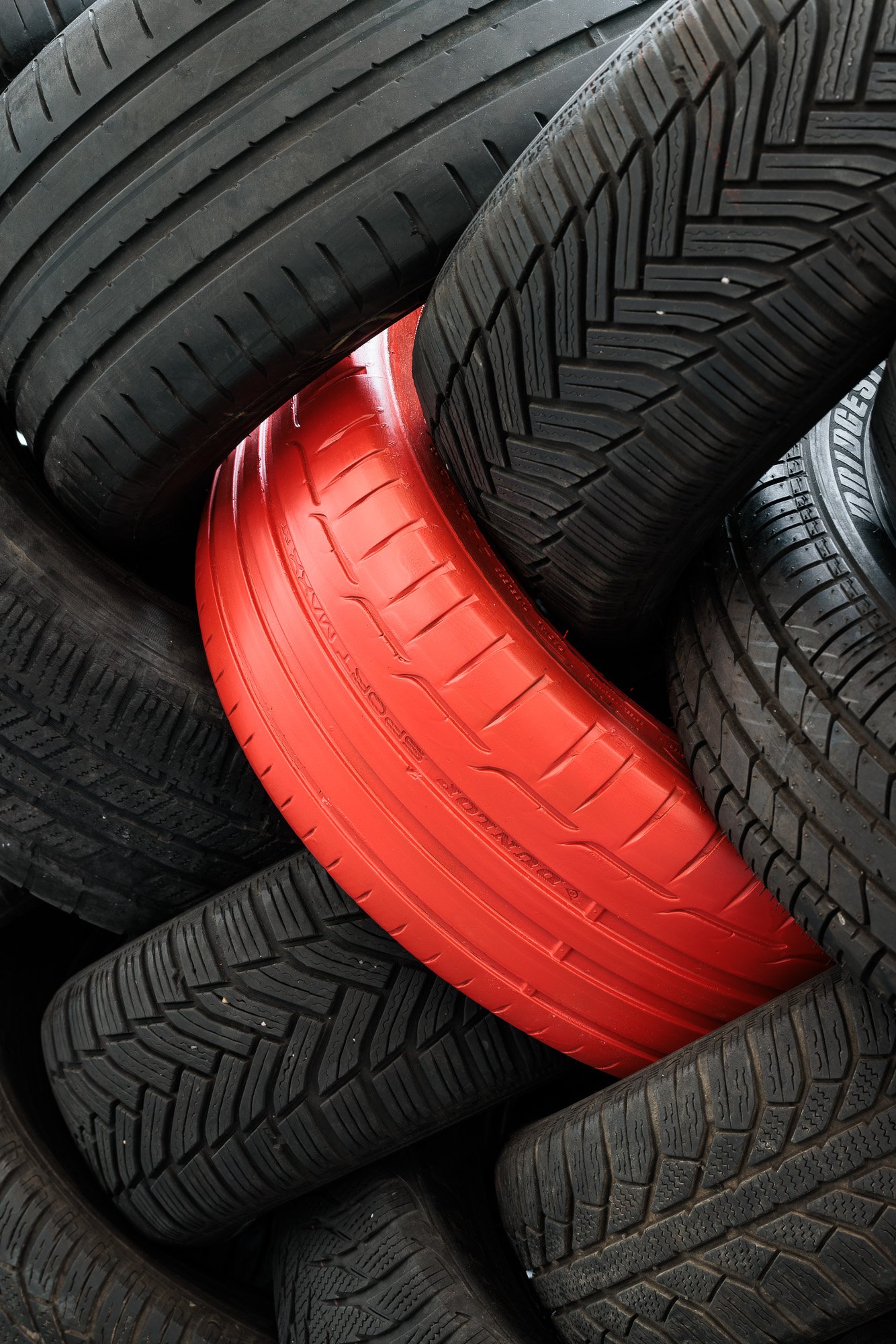
Lena Henke
A hard shoulder I, 2024
Car tires
dimensions variable

Lena Henke
A hard shoulder II, 2024
Car tires
dimensions variable
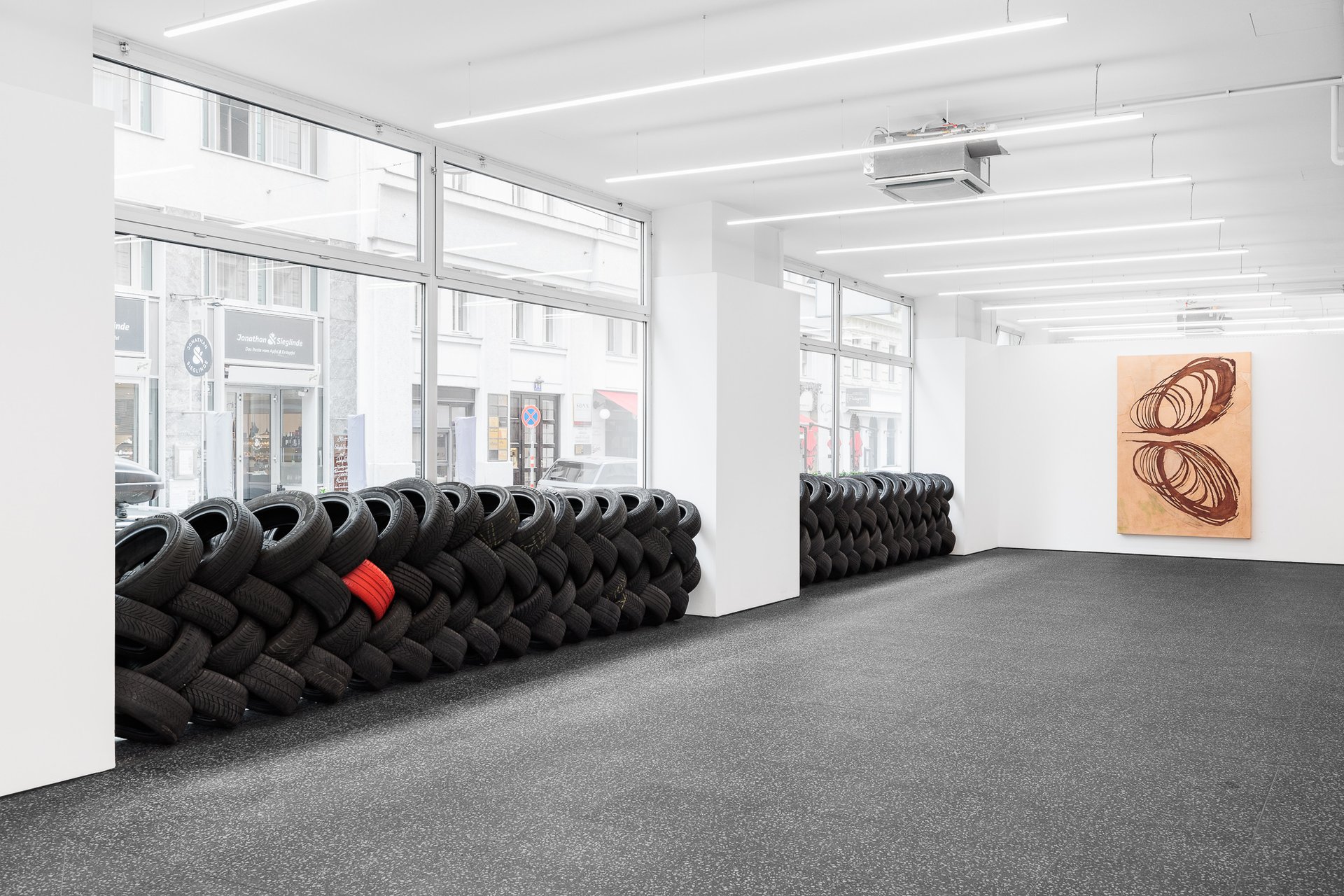
Lena Henke
Dark Glasses, 2024
Installation view
Layr Singerstraße, Vienna
![Lena HenkeCombustions 18 [Two Wheeler], 2024Laser etched leather, pigment on wooden panel250 x 170 x 15 cm](/media/images/08_0MTd6gI.width-1920.jpg)
Lena Henke
Combustions 18 [Two Wheeler], 2024
Laser etched leather, pigment on wooden panel
250 × 170 × 15 cm
![Lena HenkeCombustions 18 [Two Wheeler], 2024Laser etched leather, pigment on wooden panel250 x 170 x 15 cm](/media/images/09_RwdtpMY.width-1920.jpg)
Lena Henke
Combustions 18 [Two Wheeler], 2024
Laser etched leather, pigment on wooden panel
250 × 170 × 15 cm
![Lena HenkeCombustions 18 [Two Wheeler], 2024Laser etched leather, pigment on wooden panel250 x 170 x 15 cm](/media/images/10_mXx2otO.width-1920.jpg)
Lena Henke
Combustions 18 [Two Wheeler], 2024
Laser etched leather, pigment on wooden panel
250 × 170 × 15 cm
![Lena HenkeCombustions 18 [Two Wheeler], 2024Laser etched leather, pigment on wooden panel250 x 170 x 15 cm](/media/images/11_EKYxgf1.width-1920.jpg)
Lena Henke
Combustions 18 [Two Wheeler], 2024
Laser etched leather, pigment on wooden panel
250 × 170 × 15 cm
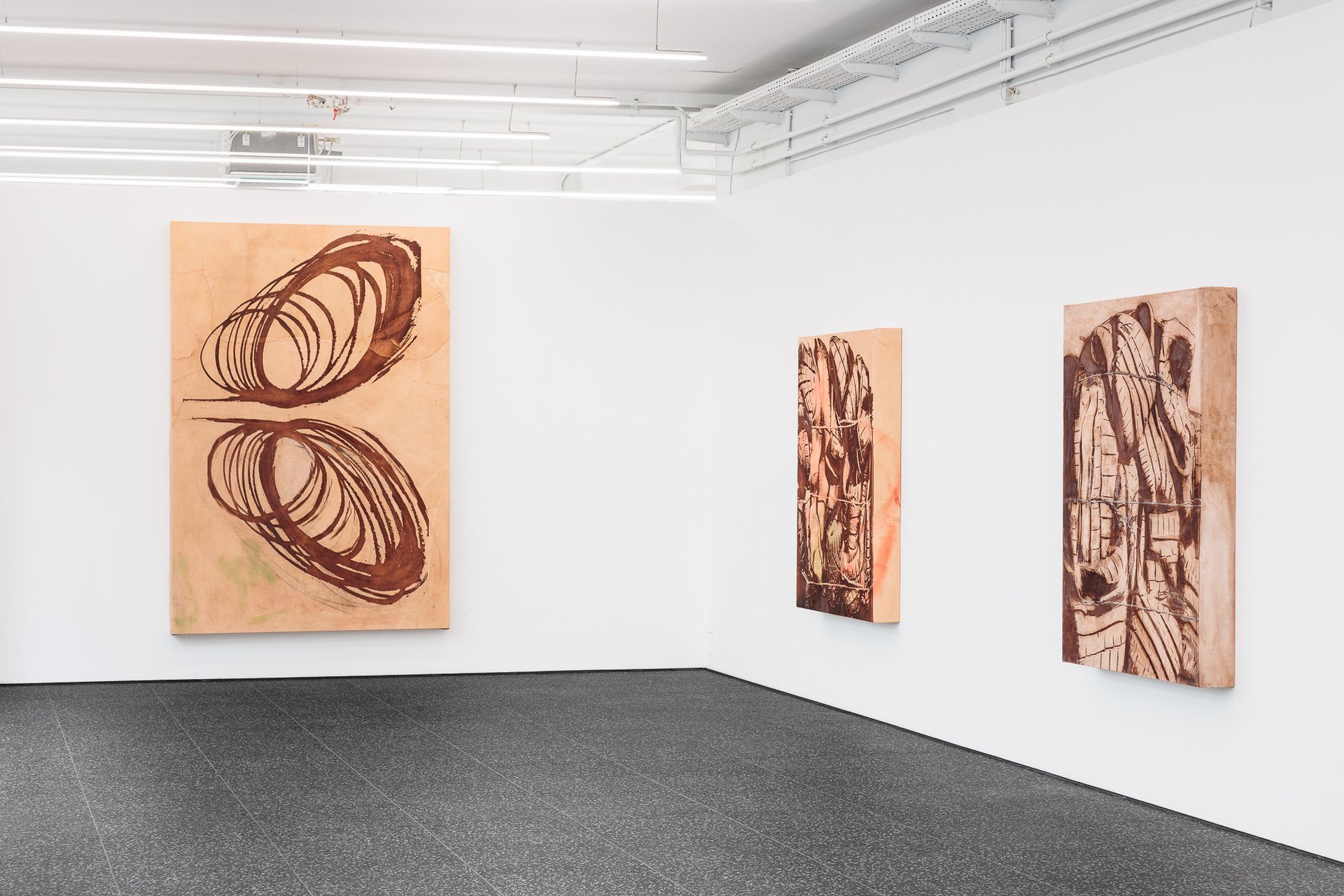
Lena Henke
Dark Glasses, 2024
Installation view
Layr Singerstraße, Vienna
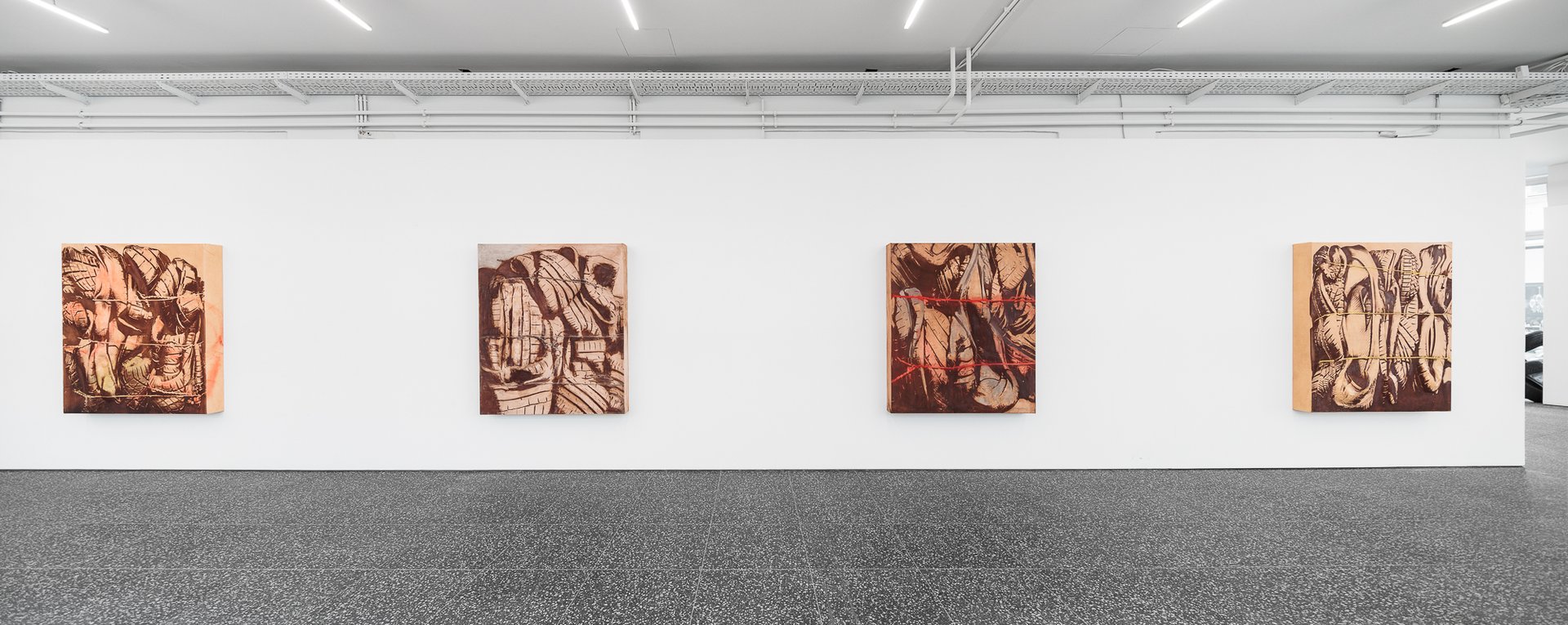
Lena Henke
Dark Glasses, 2024
Installation view
Layr Singerstraße, Vienna
![Lena HenkeCombustions 20 [Tread failure], 2024Laser etched leather, pigment on wooden panel150 x 125 x 15 cm](/media/images/13_AH3HStH.width-1920.jpg)
Lena Henke
Combustions 20 [Tread failure], 2024
Laser etched leather, pigment on wooden panel
150 × 125 × 15 cm
![Lena HenkeCombustions 20 [Tread failure], 2024Laser etched leather, pigment on wooden panel150 x 125 x 15 cm](/media/images/14_8PhTdtI.width-1920.jpg)
Lena Henke
Combustions 20 [Tread failure], 2024
Laser etched leather, pigment on wooden panel
150 × 125 × 15 cm
![Lena HenkeCombustions 20 [Tread failure], 2024Laser etched leather, pigment on wooden panel150 x 125 x 15 cm](/media/images/15_thc58jp.width-1920_Rr7CTM3.jpg)
Lena Henke
Combustions 20 [Tread failure], 2024
Laser etched leather, pigment on wooden panel
150 × 125 × 15 cm
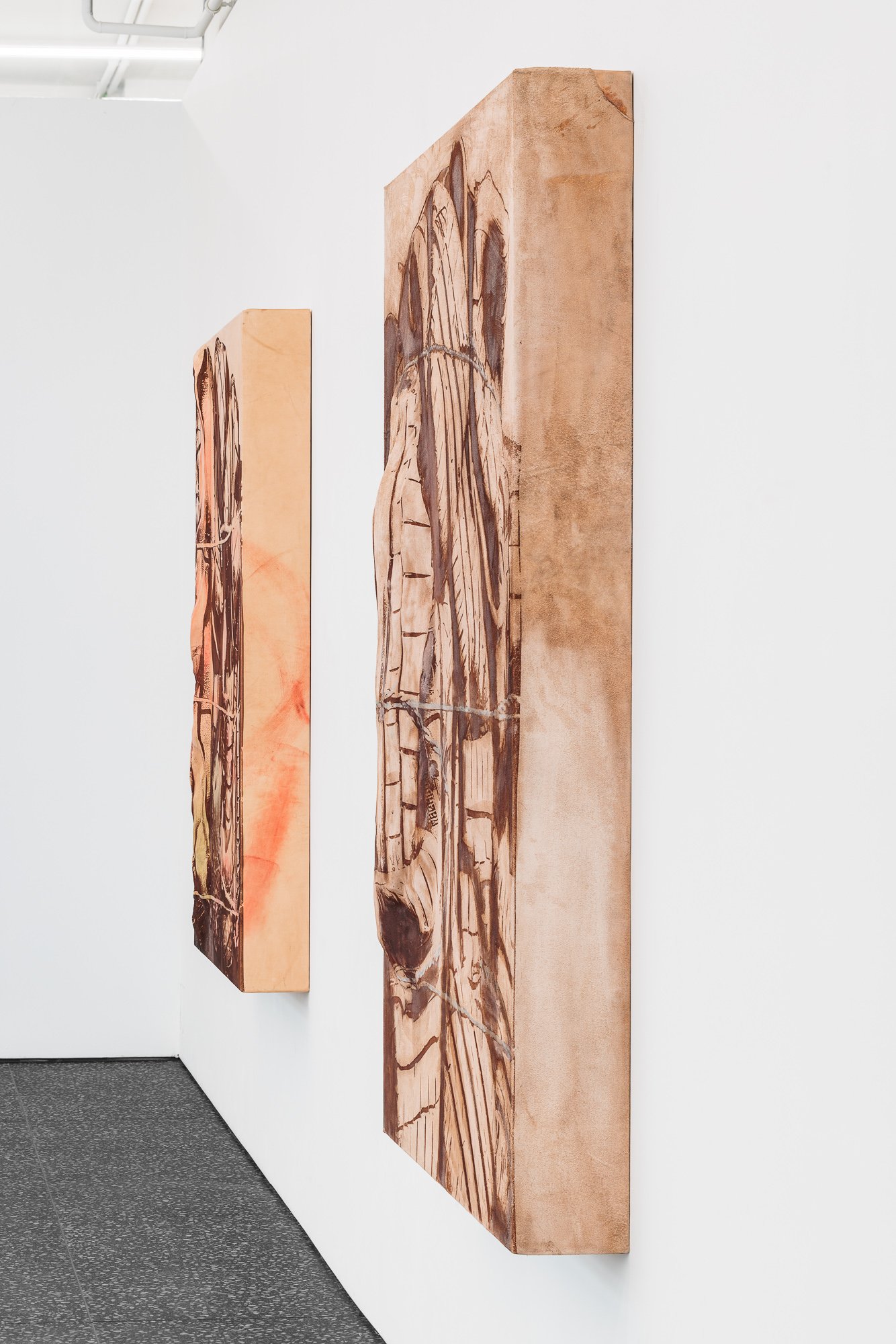
Lena Henke
Dark Glasses, 2024
Installation view
Layr Singerstraße, Vienna
![Lena HenkeCombustions 21 [Tyre bulge], 2024Laser etched leather, pigment on wooden panel150 x 125 x 15 cm](/media/images/16_zasPal5.width-1920.jpg)
Lena Henke
Combustions 21 [Tyre bulge], 2024
Laser etched leather, pigment on wooden panel
150 × 125 × 15 cm
![Lena HenkeCombustions 21 [Tyre bulge], 2024Laser etched leather, pigment on wooden panel150 x 125 x 15 cm](/media/images/17_cdczfl6.width-1920.jpg)
Lena Henke
Combustions 21 [Tyre bulge], 2024
Laser etched leather, pigment on wooden panel
150 × 125 × 15 cm
![Lena HenkeCombustions 21 [Tyre bulge], 2024Laser etched leather, pigment on wooden panel150 x 125 x 15 cm](/media/images/18_c7POXpM.width-1920.jpg)
Lena Henke
Combustions 21 [Tyre bulge], 2024
Laser etched leather, pigment on wooden panel
150 × 125 × 15 cm
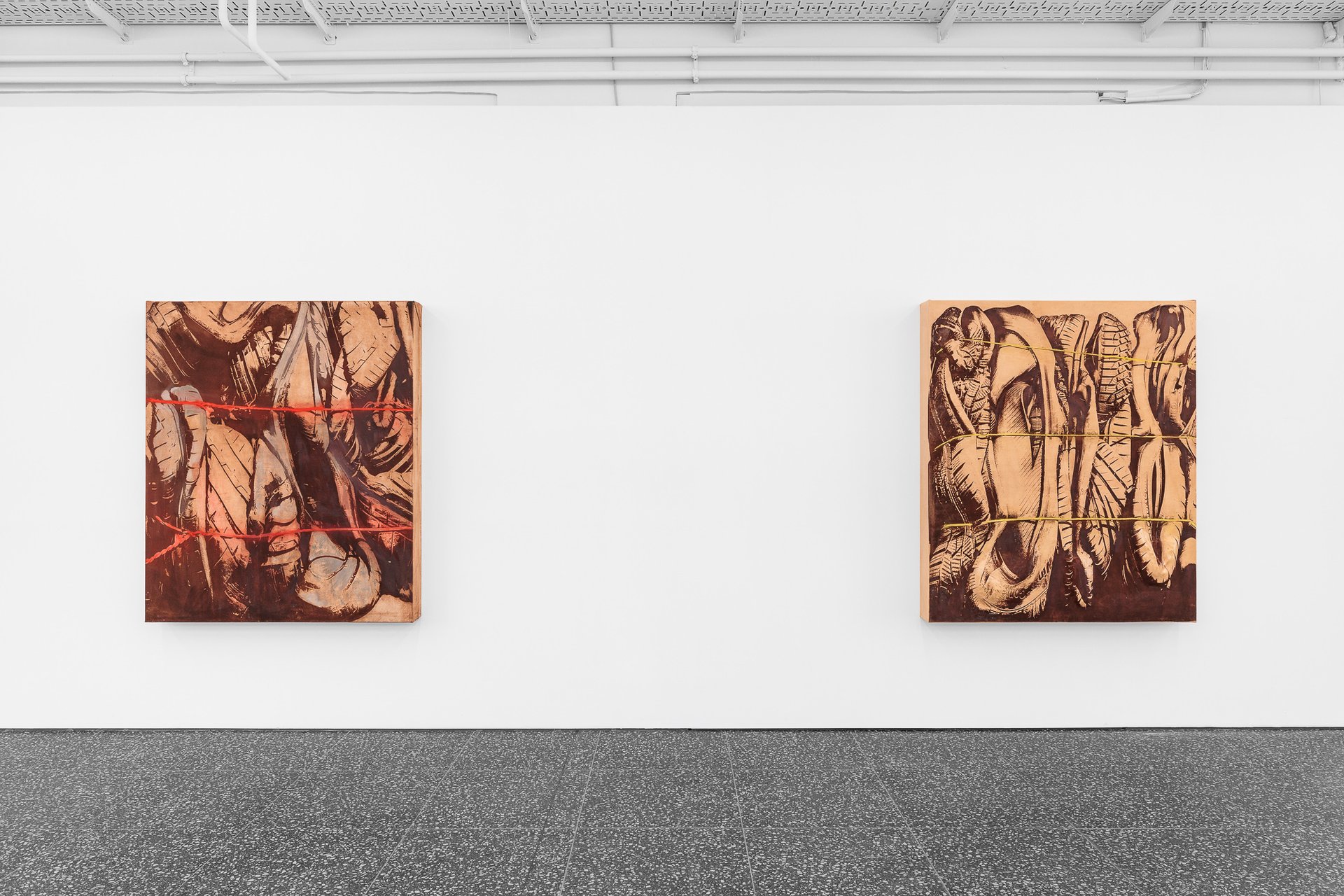
Lena Henke
Dark Glasses, 2024
Installation view
Layr Singerstraße, Vienna
![Lena HenkeCombustions 22 [Penetration damage], 2024Laser etched leather, pigment on wooden panel150 x 125 x 15 cm](/media/images/21_K2q9jr7.width-1920.jpg)
Lena Henke
Combustions 22 [Penetration damage], 2024
Laser etched leather, pigment on wooden panel
150 × 125 × 15 cm
![Lena HenkeCombustions 22 [Penetration damage], 2024Laser etched leather, pigment on wooden panel150 x 125 x 15 cm](/media/images/22_bDgTeS4.width-1920.jpg)
Lena Henke
Combustions 22 [Penetration damage], 2024
Laser etched leather, pigment on wooden panel
150 × 125 × 15 cm
![Lena HenkeCombustions 22 [Penetration damage], 2024Laser etched leather, pigment on wooden panel150 x 125 x 15 cm](/media/images/23_nt3sD5M.width-1920.jpg)
Lena Henke
Combustions 22 [Penetration damage], 2024
Laser etched leather, pigment on wooden panel
150 × 125 × 15 cm
![Lena HenkeLena Henke, Combustions 23 [Sidewall failure], 2024Laser etched leather, pigment on wooden panel150 x 125 x 15 cm](/media/images/24_xhOOlkv.width-1920.jpg)
Lena Henke
Lena Henke, Combustions 23 [Sidewall failure], 2024
Laser etched leather, pigment on wooden panel
150 × 125 × 15 cm
![Lena HenkeLena Henke, Combustions 23 [Sidewall failure], 2024Laser etched leather, pigment on wooden panel150 x 125 x 15 cm](/media/images/25_1A1k06s.width-1920.jpg)
Lena Henke
Lena Henke, Combustions 23 [Sidewall failure], 2024
Laser etched leather, pigment on wooden panel
150 × 125 × 15 cm
![Lena HenkeLena Henke, Combustions 23 [Sidewall failure], 2024Laser etched leather, pigment on wooden panel150 x 125 x 15 cm](/media/images/26_ISENVLM.width-1920.jpg)
Lena Henke
Lena Henke, Combustions 23 [Sidewall failure], 2024
Laser etched leather, pigment on wooden panel
150 × 125 × 15 cm
![Lena HenkeLena Henke, Combustions 23 [Sidewall failure], 2024Laser etched leather, pigment on wooden panel150 x 125 x 15 cm](/media/images/27_Azw1xGP.width-1920.jpg)
Lena Henke
Lena Henke, Combustions 23 [Sidewall failure], 2024
Laser etched leather, pigment on wooden panel
150 × 125 × 15 cm

Lena Henke
Dark Glasses, 2024
Installation view
Layr Singerstraße, Vienna
![Lena HenkeLena Henke, Combustions 19 [The belly of my car], 2024Laser etched leather, pigment on wooden panel150 x 125 x 15 cm](/media/images/30_IJyvRou.width-1920.jpg)
Lena Henke
Lena Henke, Combustions 19 [The belly of my car], 2024
Laser etched leather, pigment on wooden panel
150 × 125 × 15 cm
![Lena HenkeLena Henke, Combustions 19 [The belly of my car], 2024Laser etched leather, pigment on wooden panel150 x 125 x 15 cm](/media/images/31_9FFMLFq.width-1920.jpg)
Lena Henke
Lena Henke, Combustions 19 [The belly of my car], 2024
Laser etched leather, pigment on wooden panel
150 × 125 × 15 cm
![Lena HenkeLena Henke, Combustions 19 [The belly of my car], 2024Laser etched leather, pigment on wooden panel150 x 125 x 15 cm](/media/images/32_i7MW5W0.width-1920.jpg)
Lena Henke
Lena Henke, Combustions 19 [The belly of my car], 2024
Laser etched leather, pigment on wooden panel
150 × 125 × 15 cm
![Lena HenkeLena Henke, Combustions 19 [The belly of my car], 2024Laser etched leather, pigment on wooden panel150 x 125 x 15 cm](/media/images/33_Tdo6zz6.width-1920.jpg)
Lena Henke
Lena Henke, Combustions 19 [The belly of my car], 2024
Laser etched leather, pigment on wooden panel
150 × 125 × 15 cm

Lena Henke
Dark Glasses, 2024
Installation view
Layr Singerstraße, Vienna
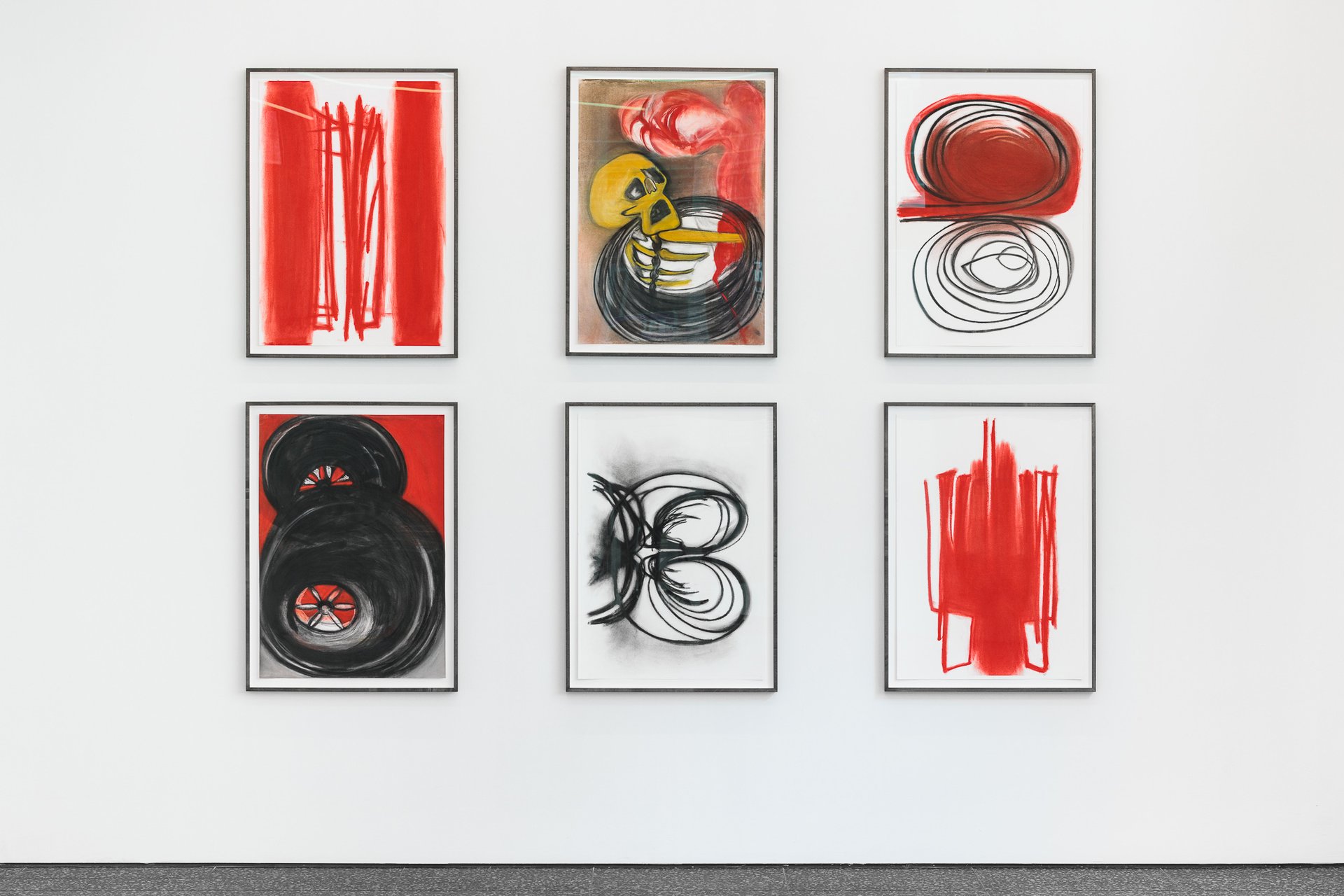
Lena Henke
Dark Glasses, 2024
Installation view
Layr Singerstraße, Vienna
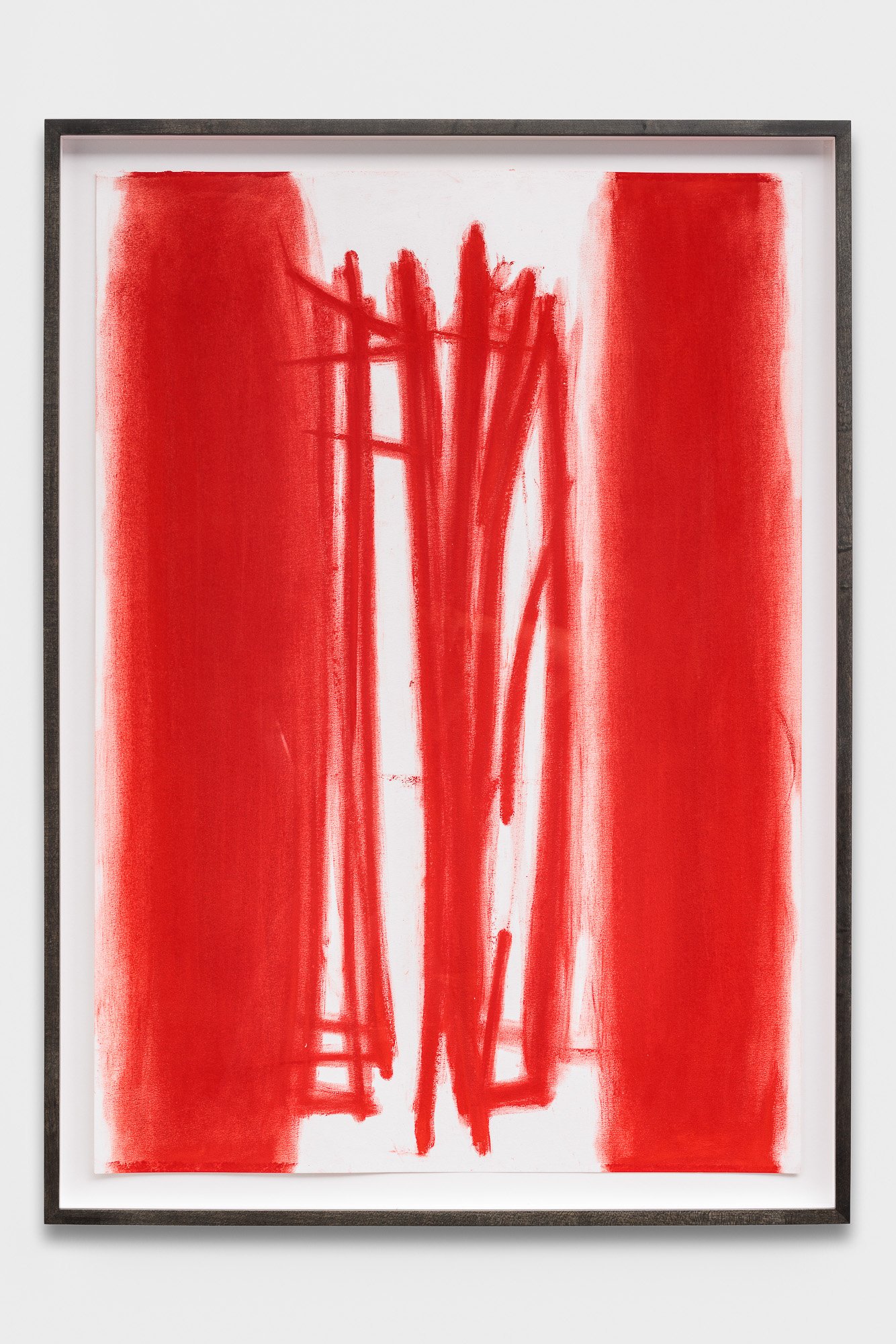
Lena Henke
Untitled, 2024
Pastel on paper in artist’s frame
92 × 67 cm (framed)
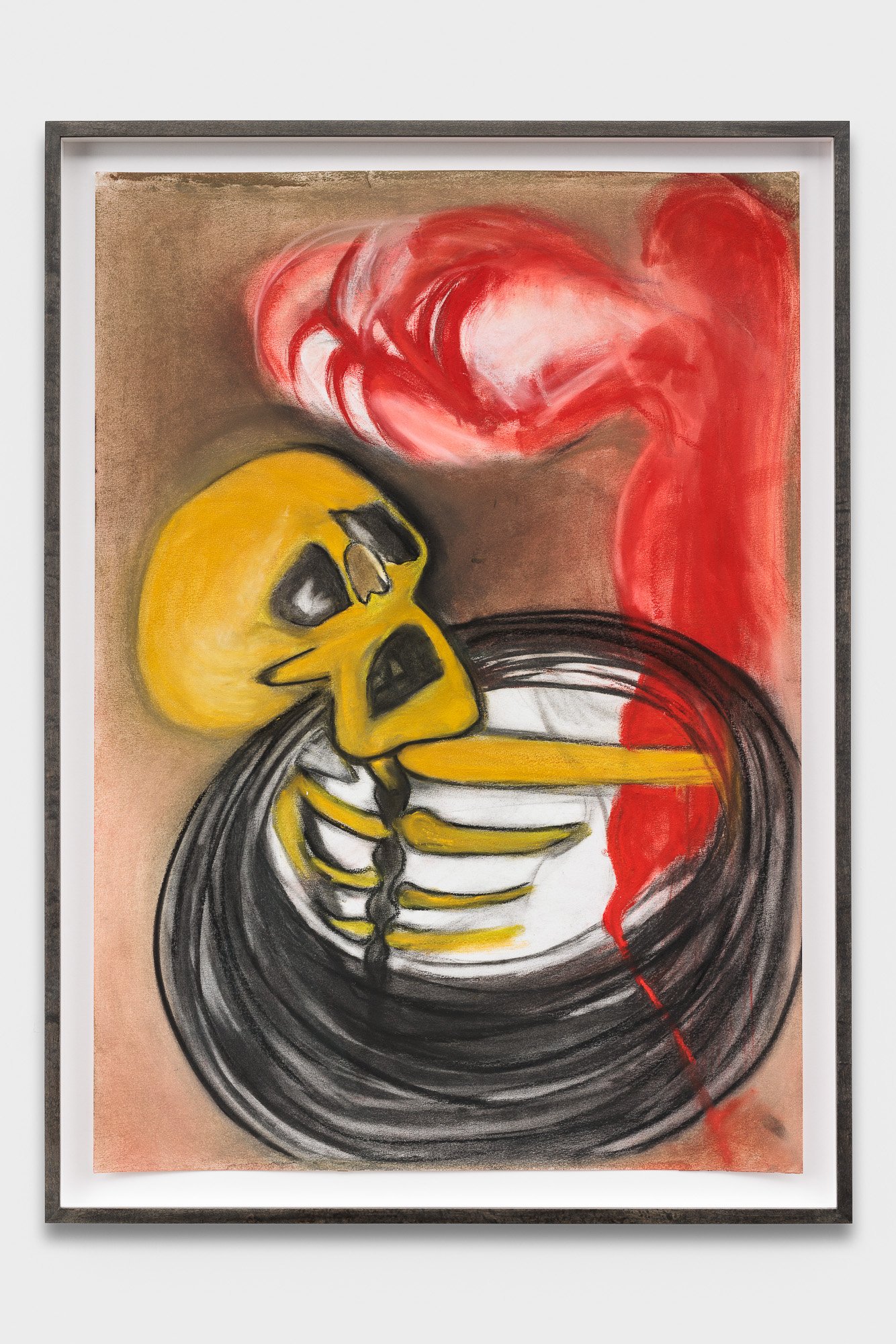
Lena Henke
Untitled, 2024
Pastel on paper in artist’s frame
92 × 67 cm (framed)
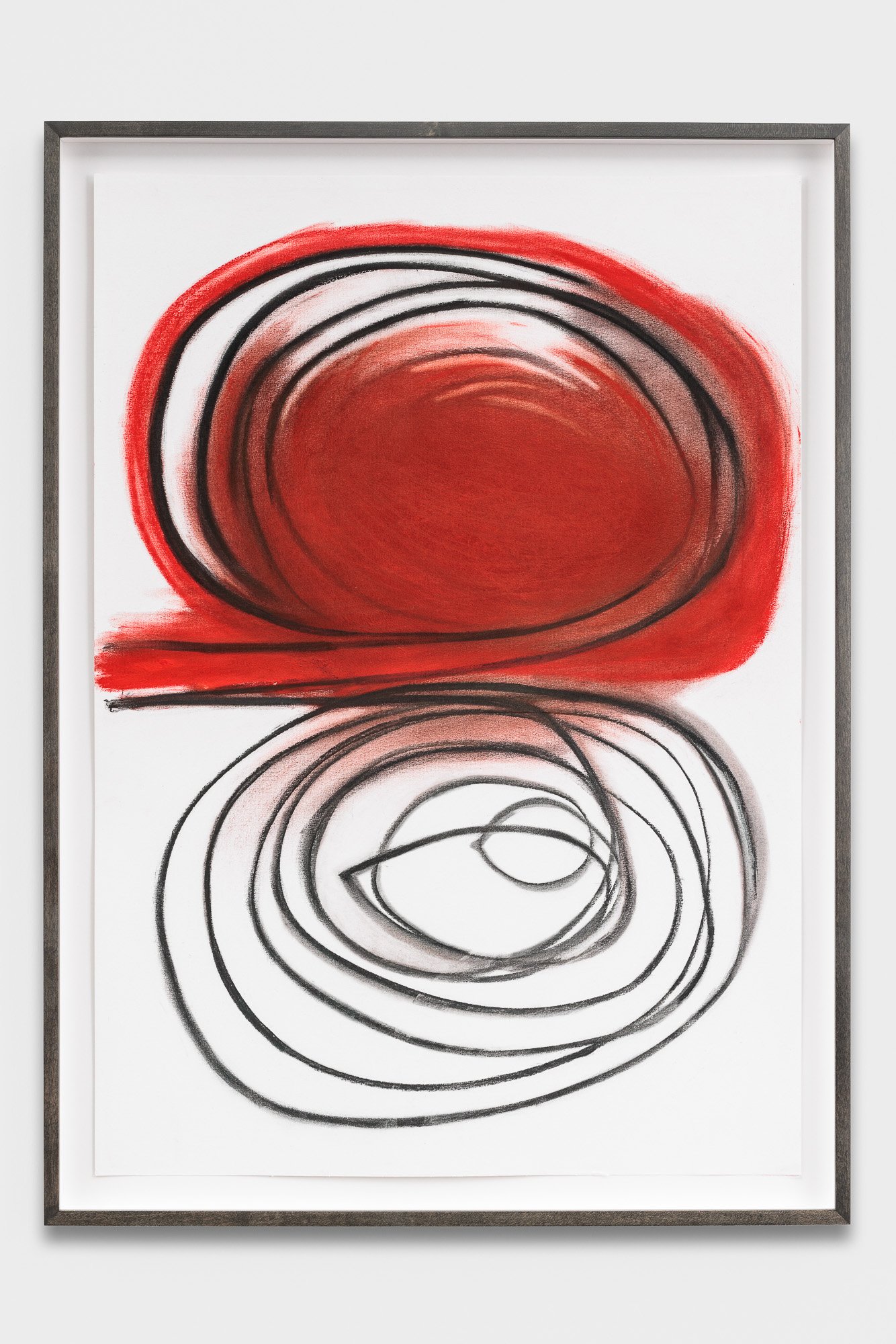
Lena Henke
Untitled, 2024
Pastel on paper in artist’s frame
92 × 67 cm (framed)
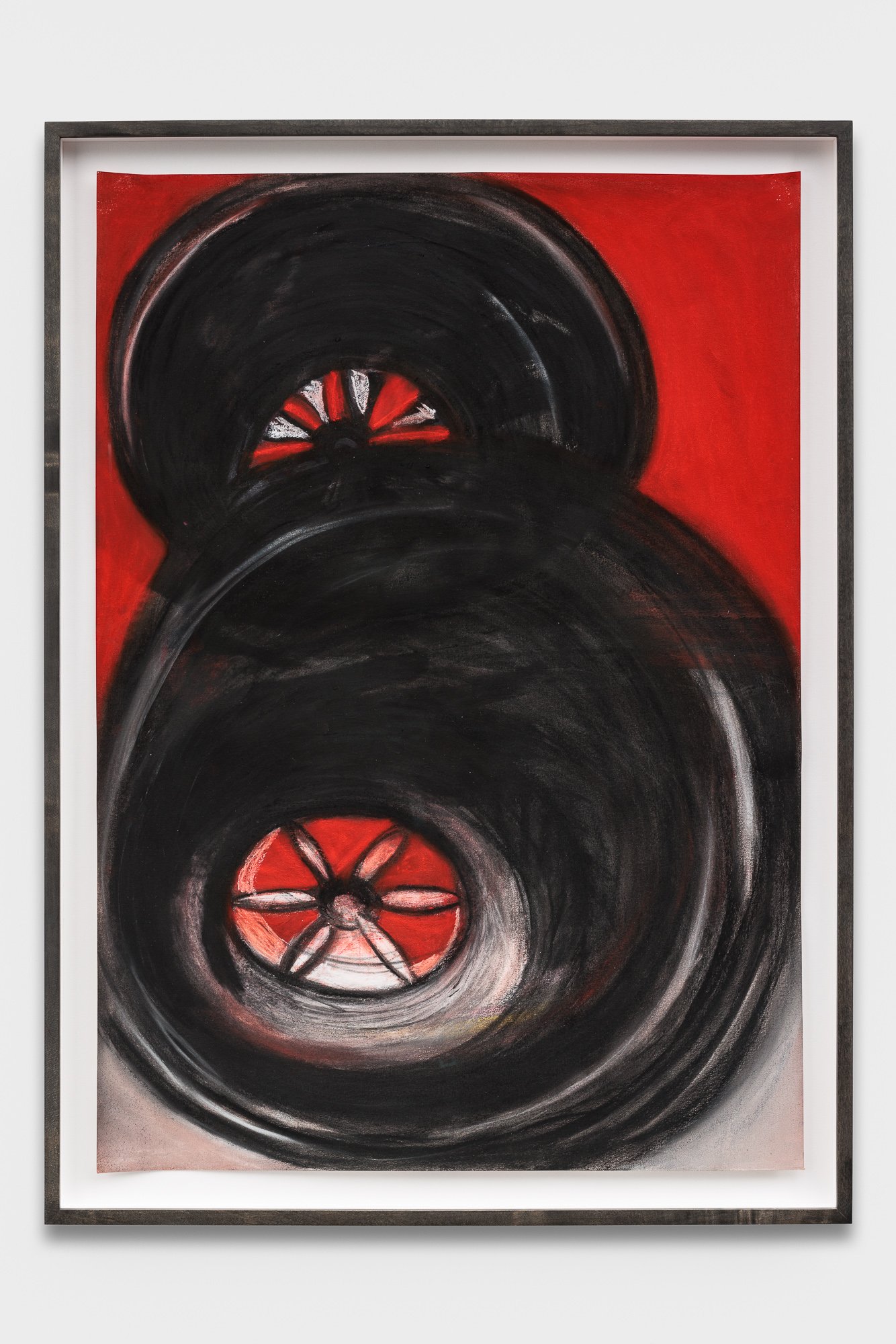
Lena Henke
Untitled, 2024
Pastel on paper in artist’s frame
92 × 67 cm (framed)
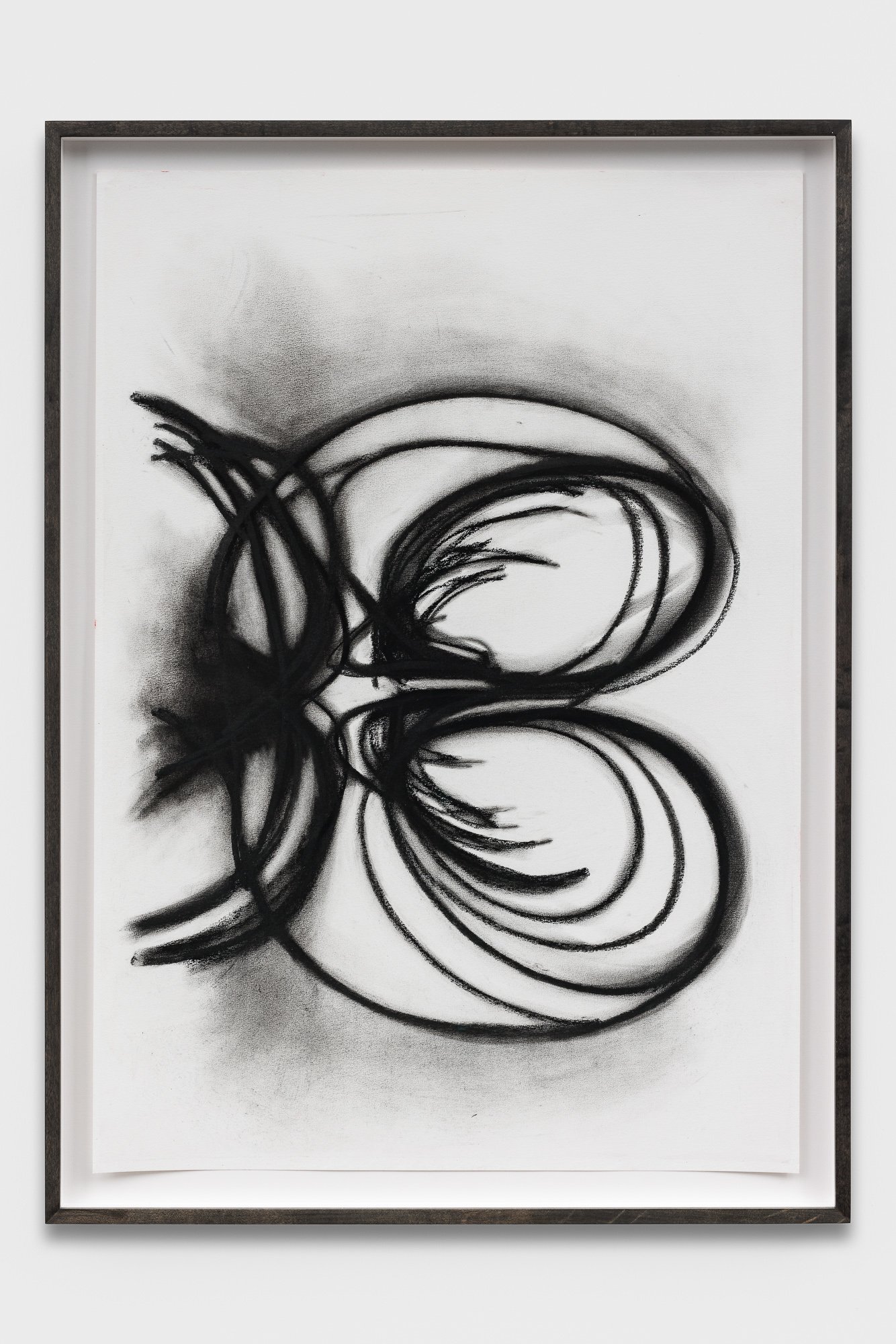
Lena Henke
Untitled, 2024
Pastel on paper in artist’s frame
92 × 67 cm (framed)
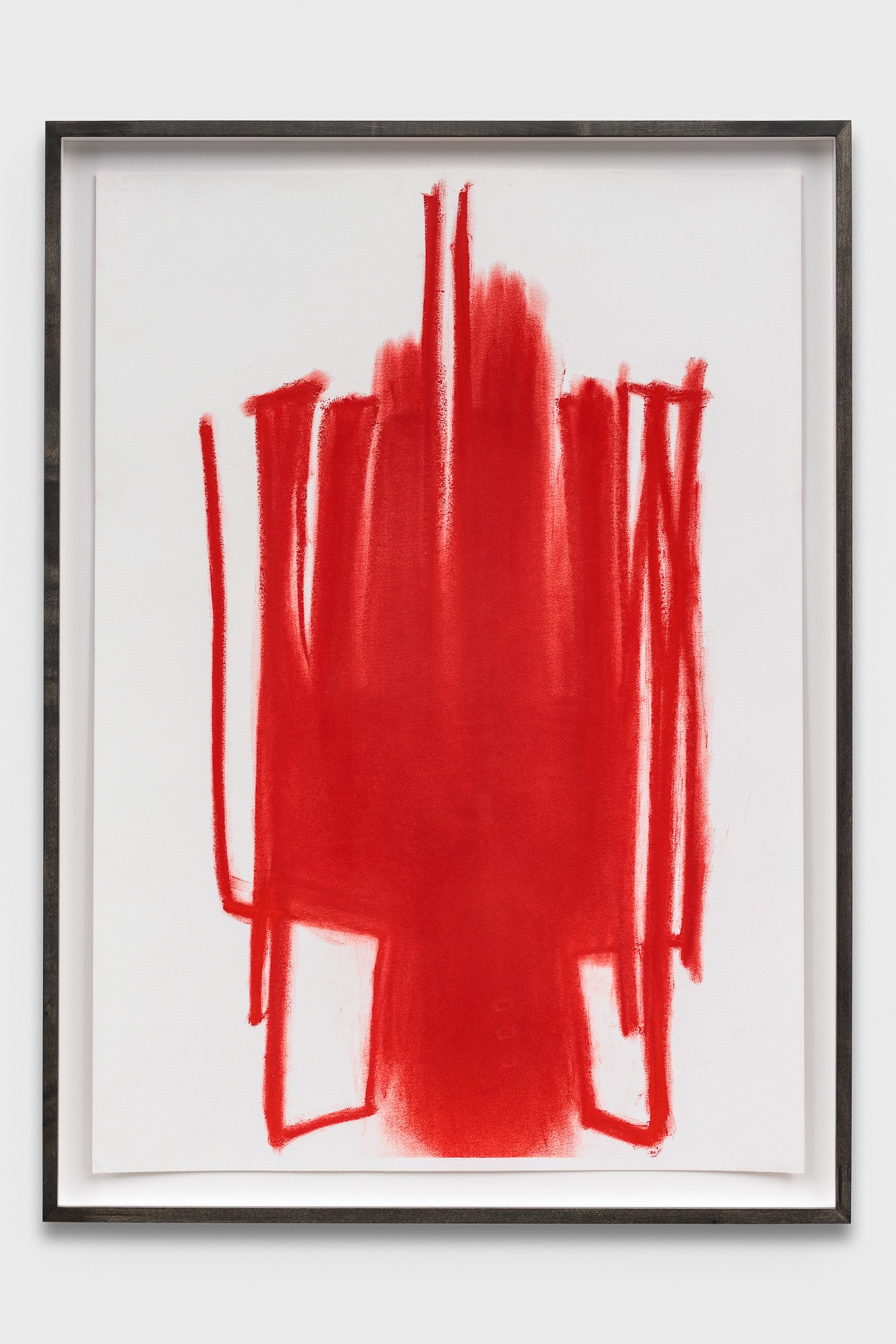
Lena Henke
Untitled, 2024
Pastel on paper in artist’s frame
92 × 67 cm (framed)
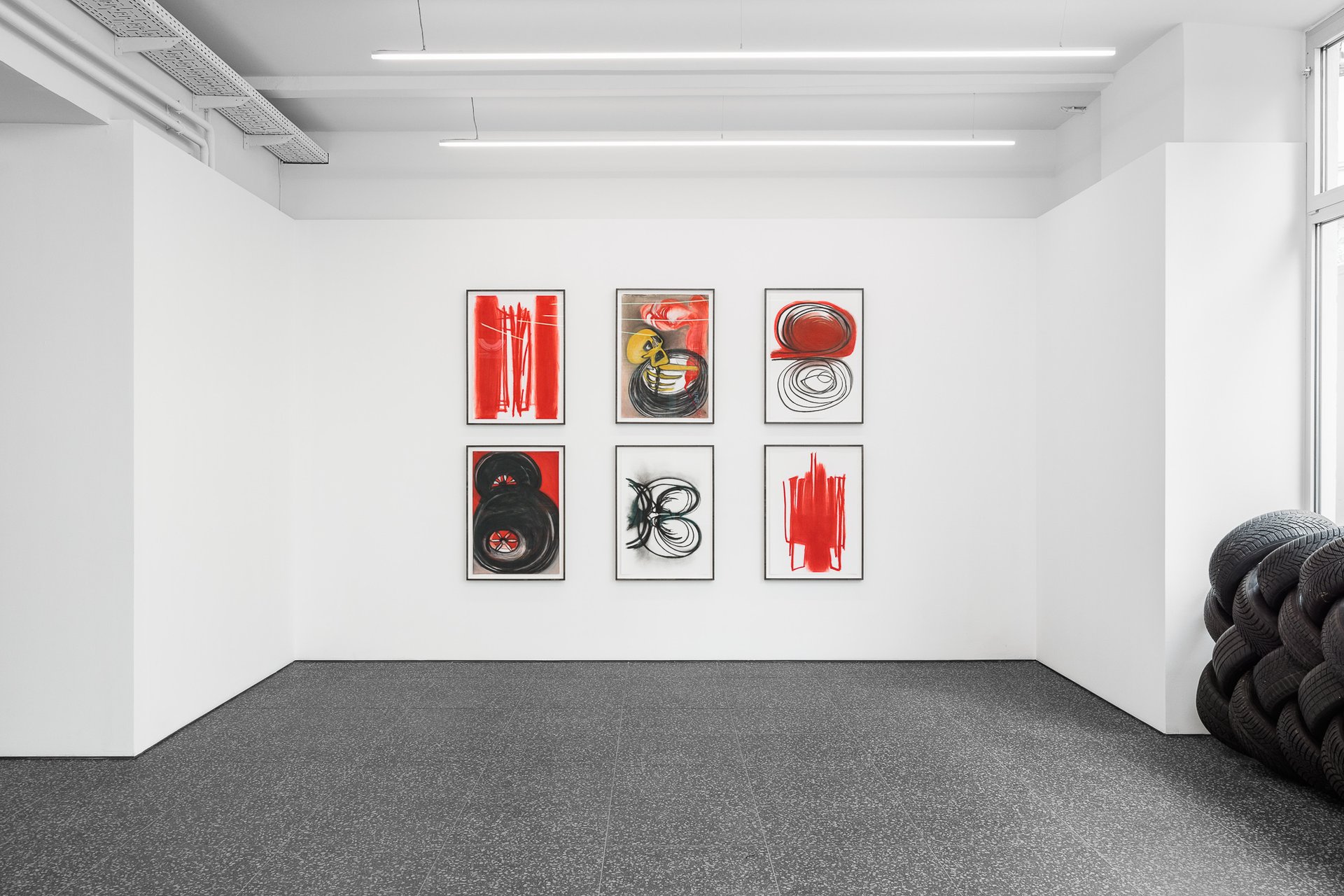
Lena Henke
Dark Glasses, 2024
Installation view
Layr Singerstraße, Vienna
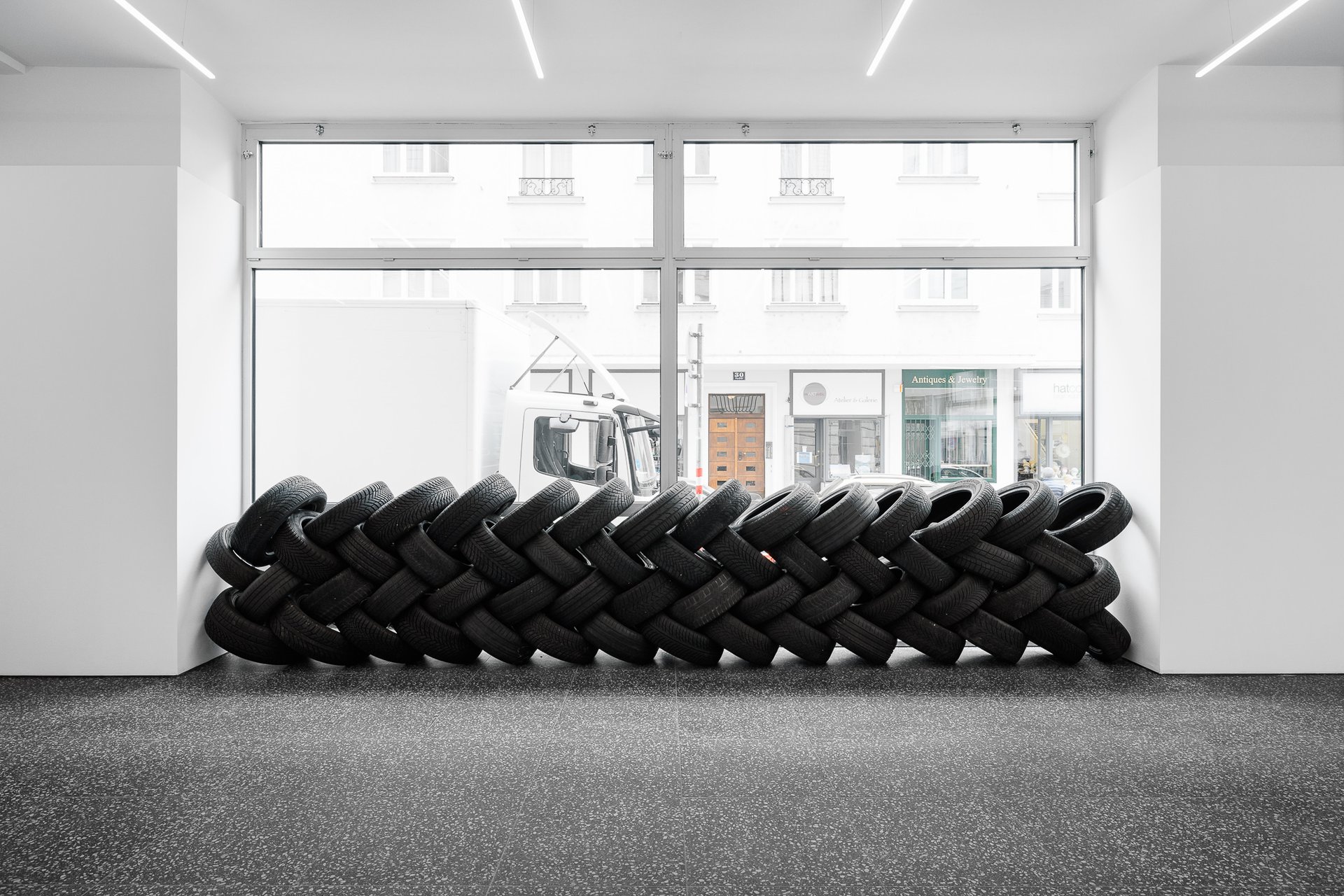
Lena Henke
A hard shoulder III, 2024
Car tires
dimensions variable
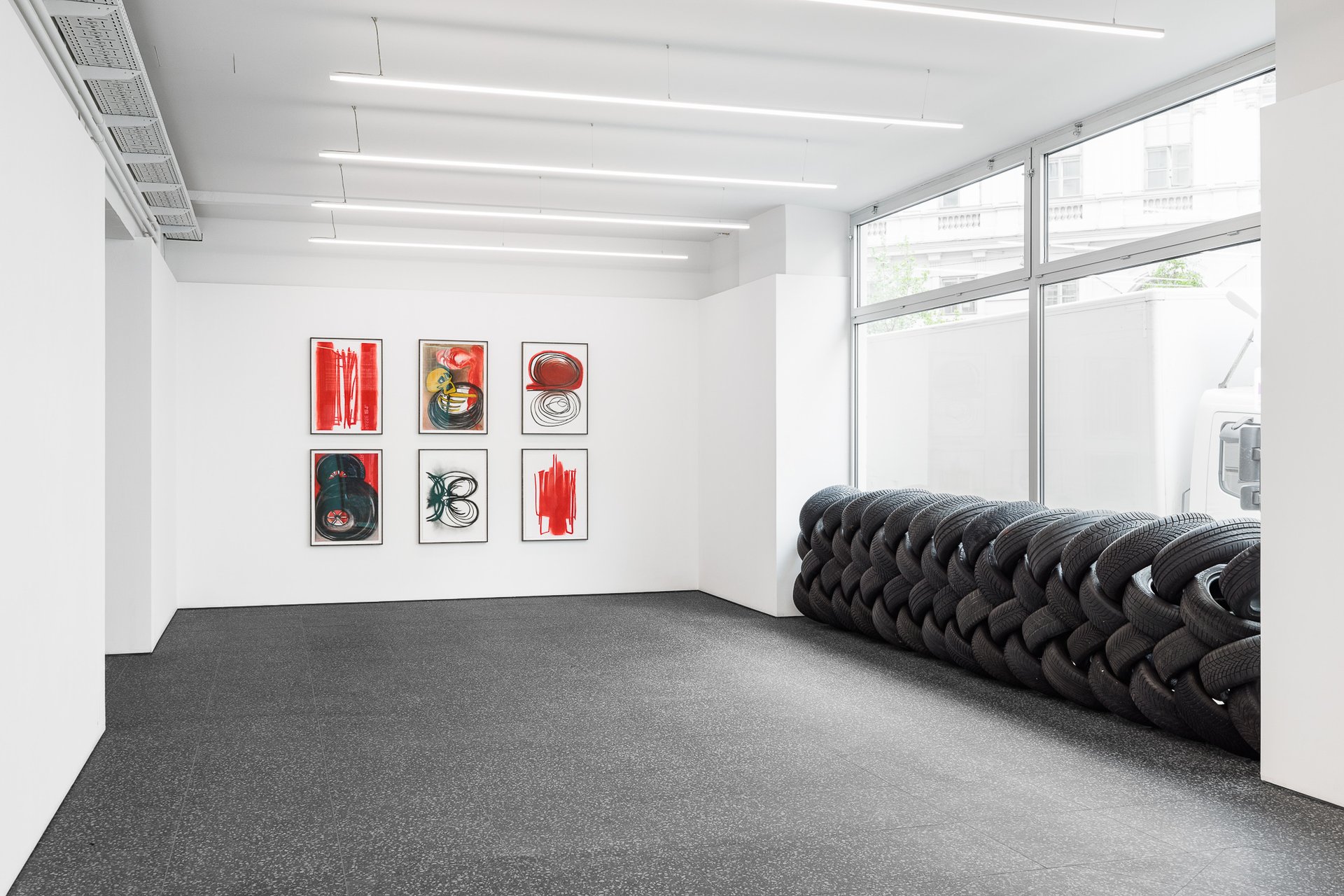
Lena Henke
Dark Glasses, 2024
Installation view
Layr Singerstraße, Vienna
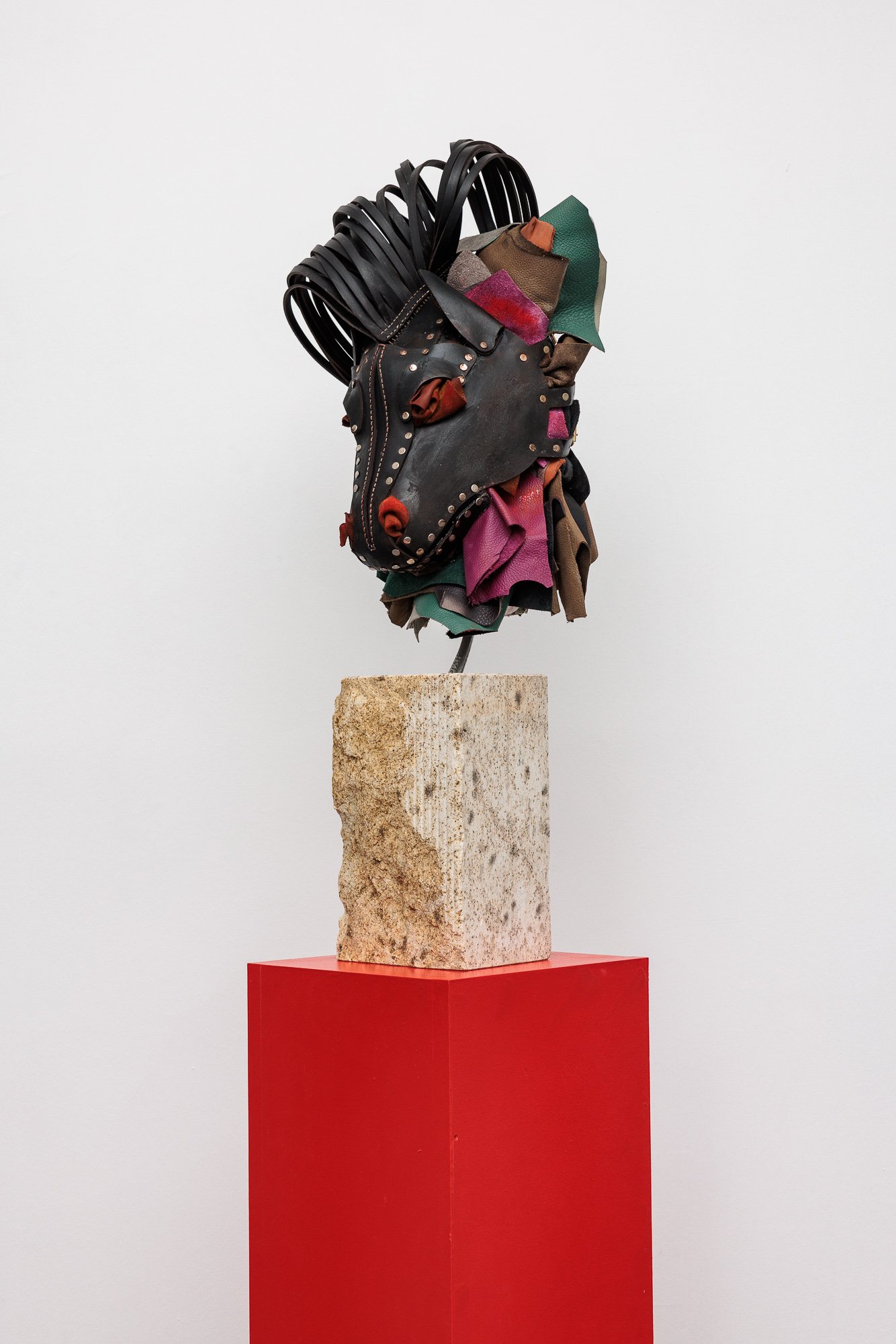
Lena Henke
Memory of a Young Sculpture XO, 2024
Soldered and boiled leather, pigment and steel mounted on Austrian granite, on wooden pedestal
30 × 30 × 167 cm (installed dimensions)
30 × 30 × 79 cm (plinth), 30 × 20 × 75 cm (stone), 35 × 30 × 58 cm (mask)
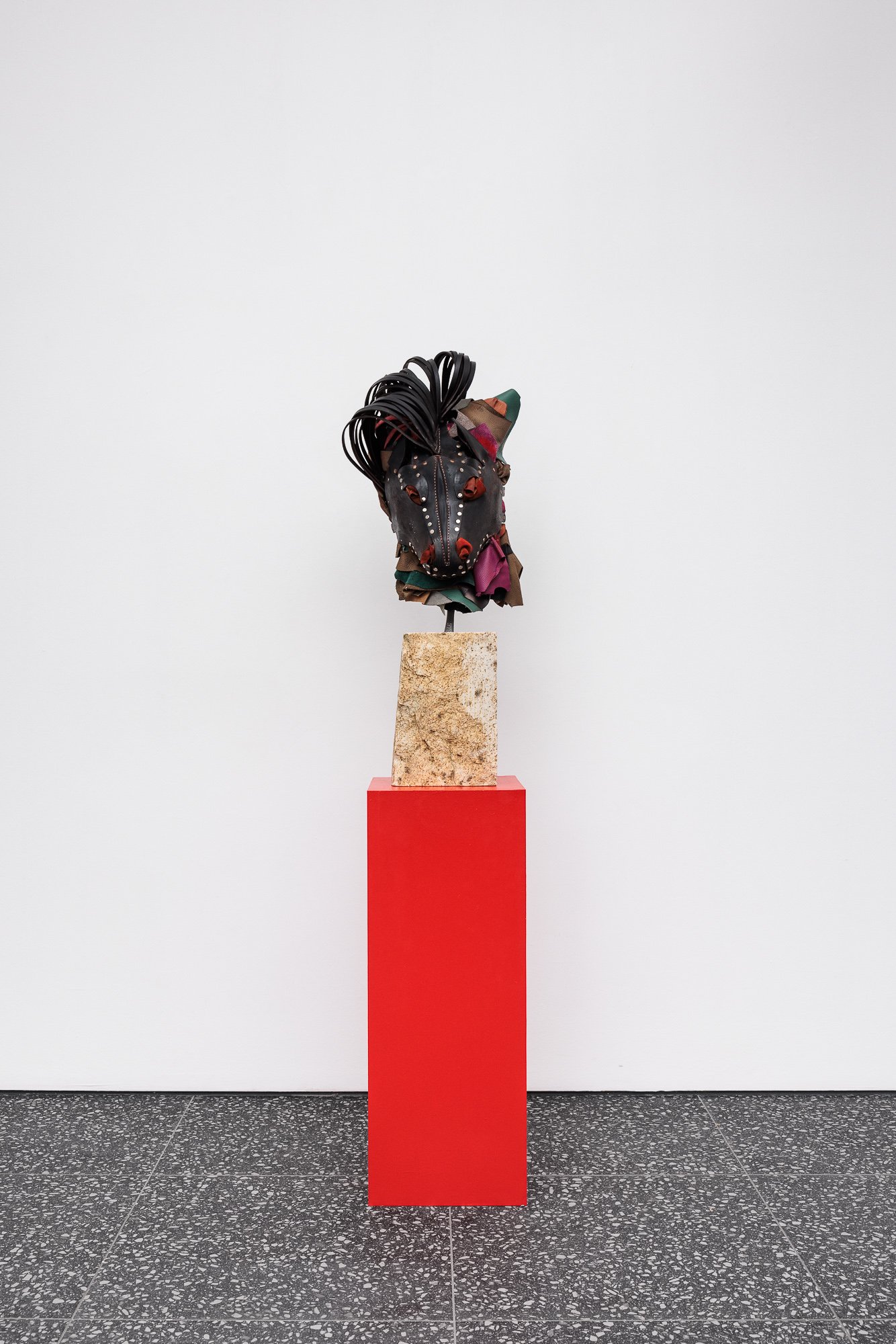
Lena Henke
Memory of a Young Sculpture XO, 2024
Soldered and boiled leather, pigment and steel mounted on Austrian granite, on wooden pedestal
30 × 30 × 167 cm (installed dimensions)
30 × 30 × 79 cm (plinth), 30 × 20 × 75 cm (stone), 35 × 30 × 58 cm (mask)
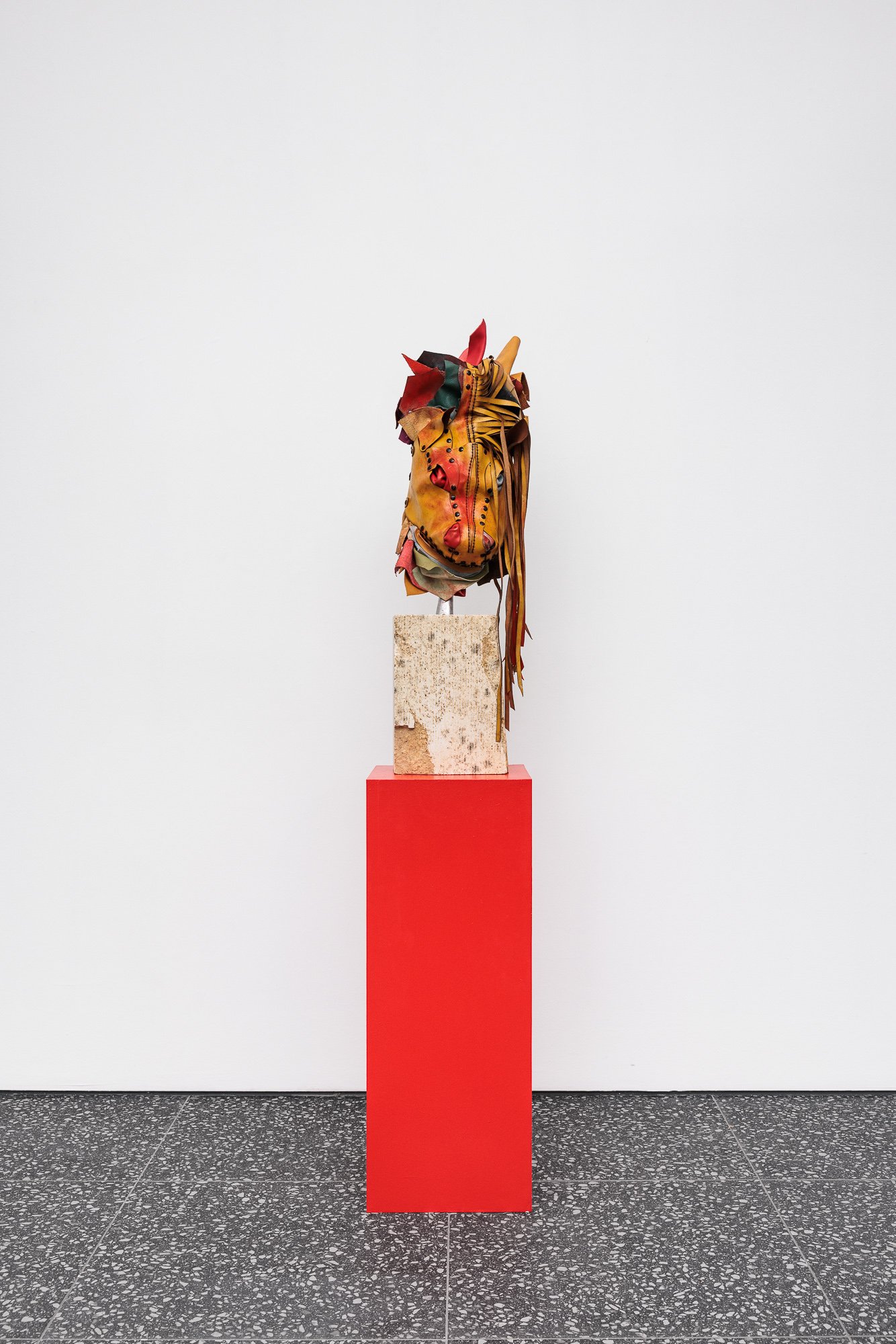
Lena Henke
Memory of a Young Sculpture X, 2024
Soldered and boiled leather, pigment and steel mounted on Austrian granite, on wooden pedestal
30 × 30 × 167 cm (installed dimensions) / 30 × 30 × 87 cm (dimensions without plinth)
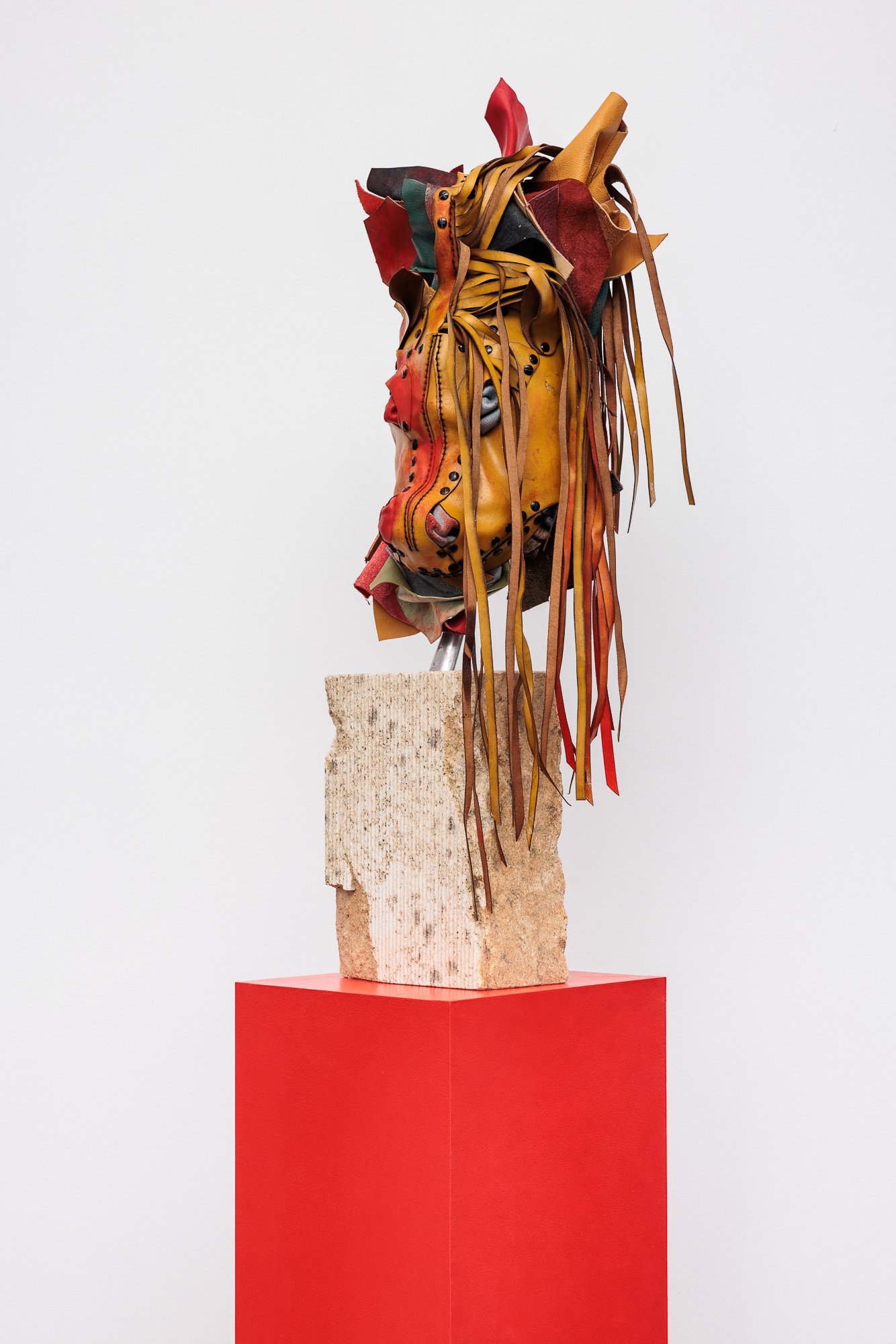
Lena Henke
Memory of a Young Sculpture X, 2024
Soldered and boiled leather, pigment and steel mounted on Austrian granite, on wooden pedestal
30 × 30 × 167 cm (installed dimensions) / 30 × 30 × 87 cm (dimensions without plinth)
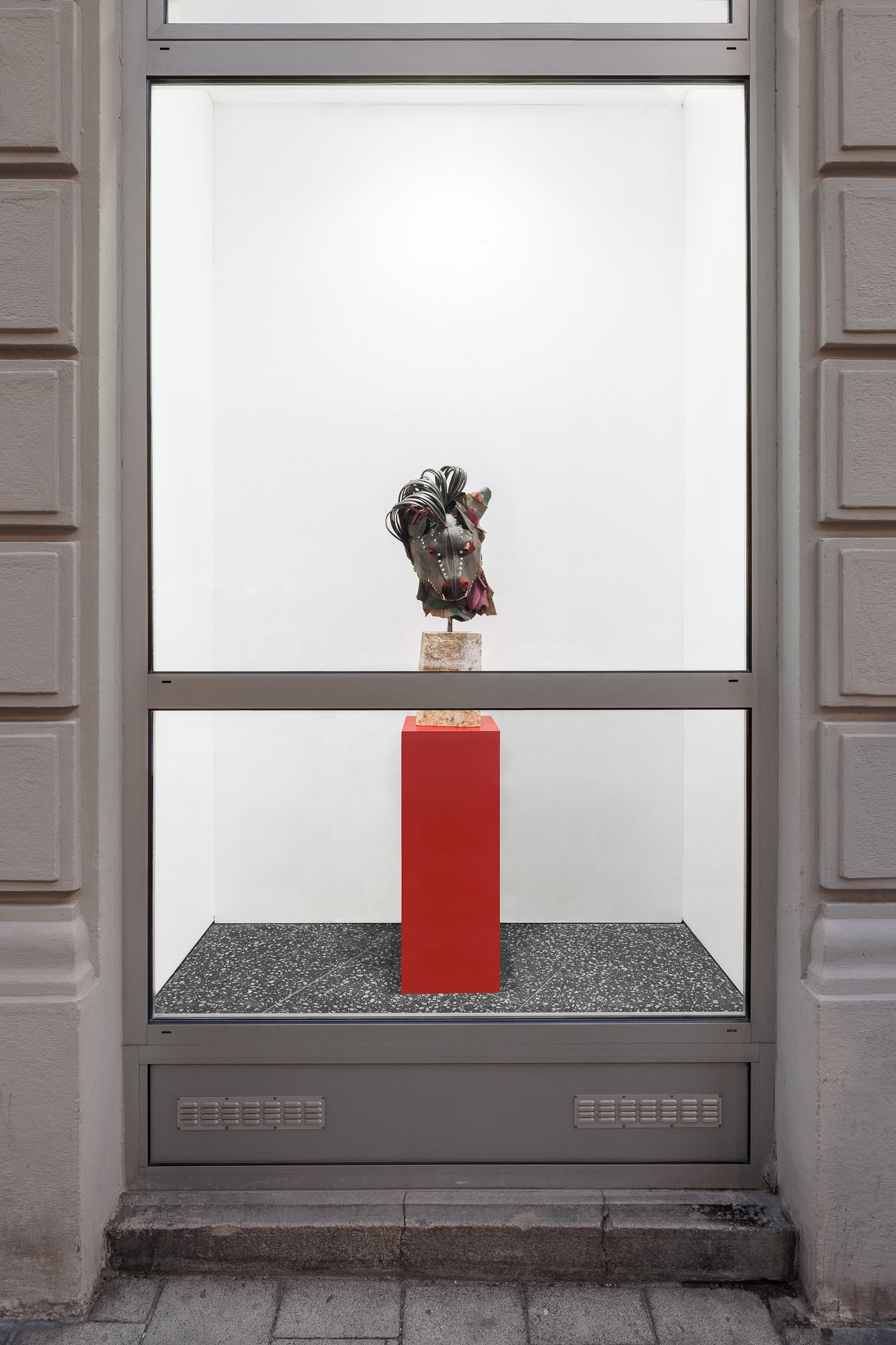
Lena Henke
Memory of a Young Sculpture XO, 2024
Soldered and boiled leather, pigment and steel mounted on Austrian granite, on wooden pedestal
30 × 30 × 167 cm (installed dimensions)
30 × 30 × 79 cm (plinth), 30 × 20 × 75 cm (stone), 35 × 30 × 58 cm (mask)

Lena Henke
Memory of a Young Sculpture X, 2024
Soldered and boiled leather, pigment and steel mounted on Austrian granite, on wooden pedestal
30 × 30 × 167 cm (installed dimensions) / 30 × 30 × 87 cm (dimensions without plinth)

Lena Henke
Dark Glasses, 2024
Installation view
Layr Singerstraße, Vienna
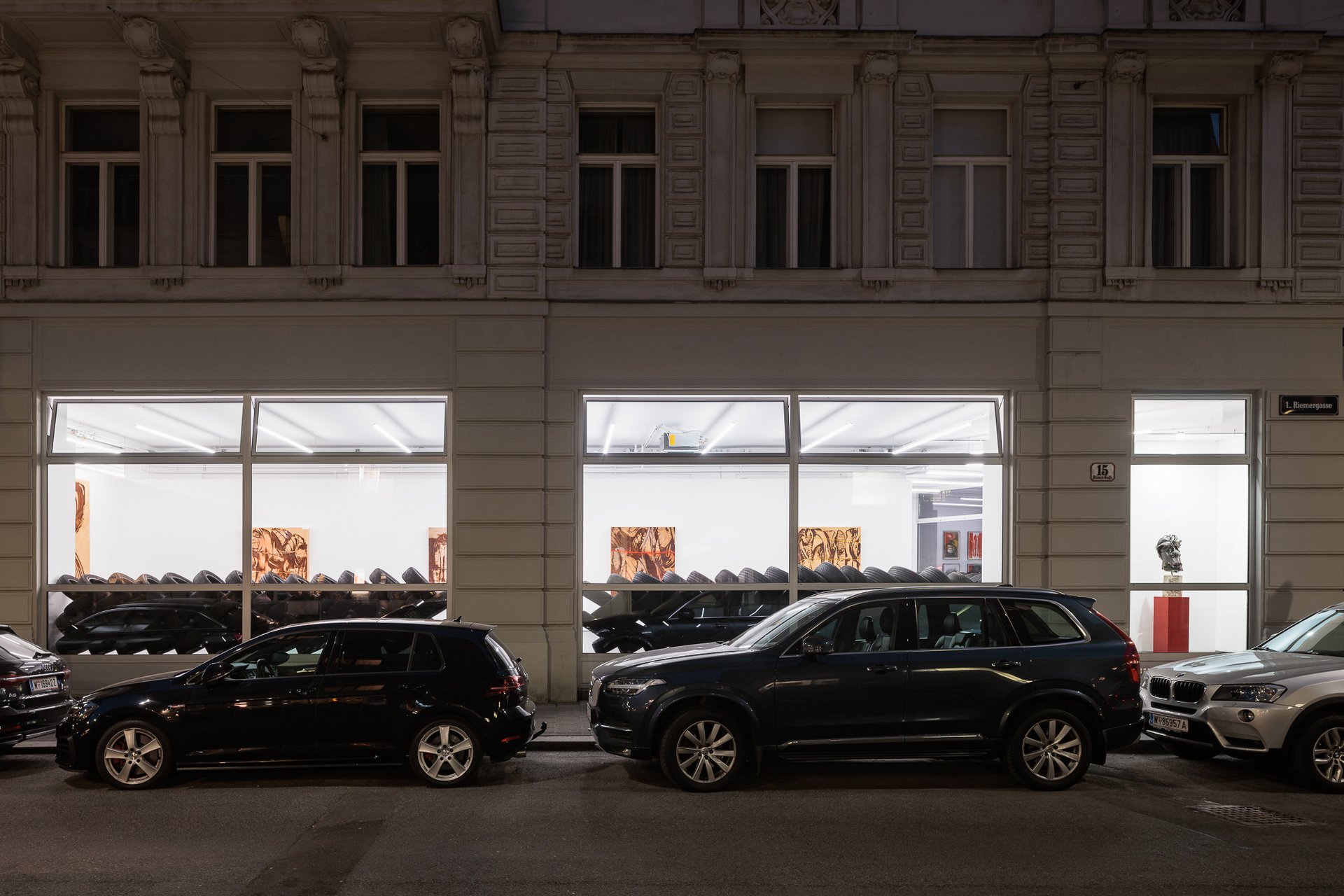
Lena Henke
Dark Glasses, 2024
Installation view
Layr Singerstraße, Vienna
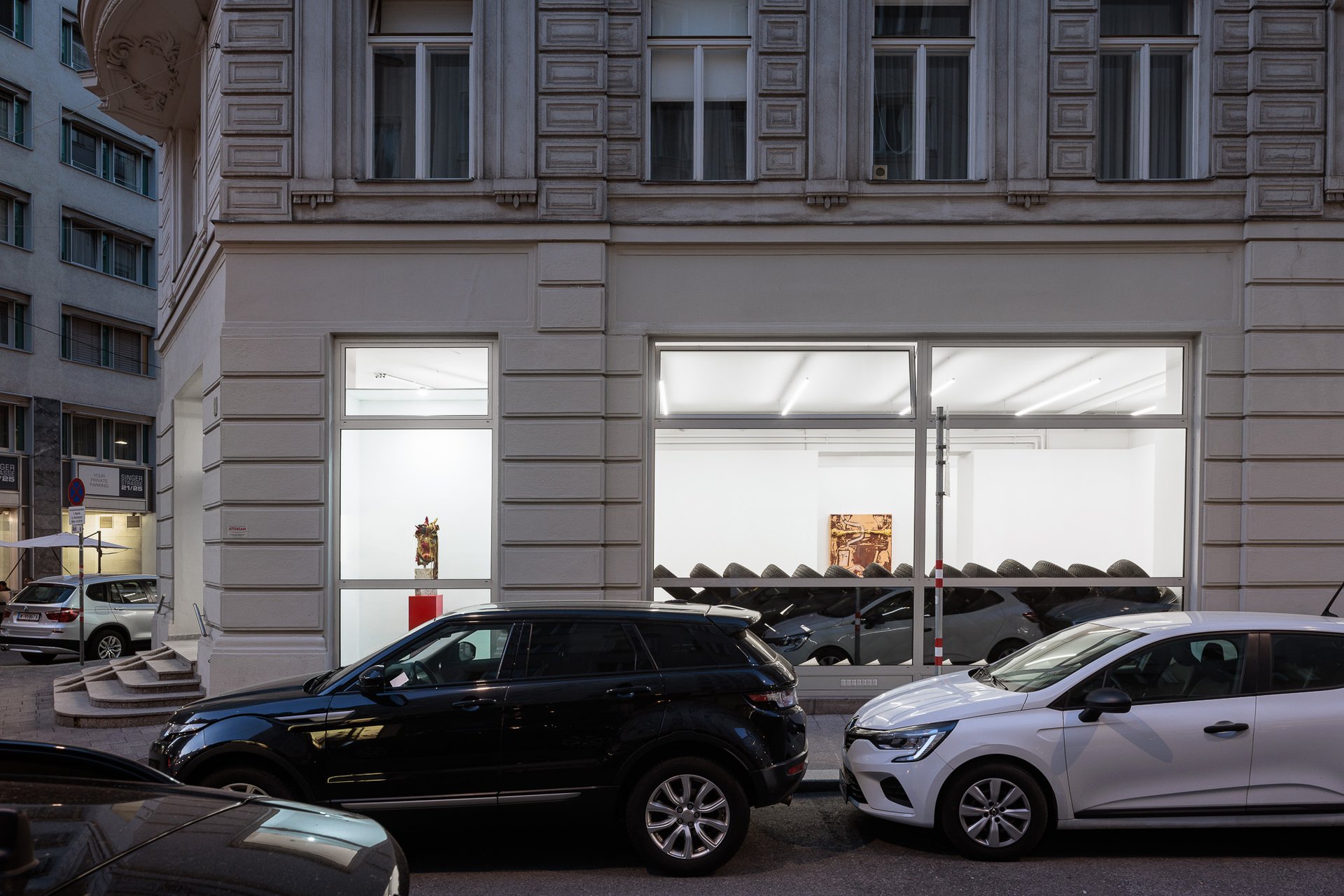
Lena Henke
Dark Glasses, 2024
Installation view
Layr Singerstraße, Vienna
All photos by Kunst-Dokumentation.com
“Just like the car, only very rarely do artifacts simultaneously bestow "incorporation" and "embodiment": we embody them, and we embody ourselves in them. This enticing, half-mystical, half-magical confluence of soul, body, and device contains the highest pleasure premiums imaginable for artifacts. This is what drives auto-fetishism.” (1)
Prelude
Imagine a motion, energy ascending from down to up and up to down.
At the bottom, you see the traces of a get-away: footsteps, high heels, horse hooves, small and big tires, perhaps overlapping. Where is she going?
From the street, what looks like a tightly knitted net of discarded leather objects is placed in front of the former shopping windows, precluding the view into the gallery space. Two horse fetish masks displayed on red plinths–mystical figures of protection–occupy the small windows beside the entrance surprising passersby as if lurking. Feminine and masculine registers overlap, play, and mix. We, the viewers, are forced to raise our height, climbing on the tip of our toes, the objects' visual entanglement to the space architecture daring our sense of self. What is on the other side?
The Wall
Lena Henke’s exhibition Dark Glasses at Layr, Vienna, continues the artist's engagement with the complex power dynamics of identity and gender, interfacing with histories of art and architecture through appropriation, control, and submission.
Taking its title from Roland Barthes's A Lover's Discourse: Fragments, (1978) withdrawing from a multiplicity of literary references to explore the whimsical phenomenon of love, the exhibition unfolds Henke’s fascination with design objects, industrial processes, and natural materials to investigate and subvert pre-set concepts juxtaposed with autobiographical references.
Engaging with the spatial features of the gallery as an architecture of potentialities, the artist confronts visitors already from the outside with three walls of tightly interlocked recycled tires visible through the former supermarket display windows. Titled A hard shoulder I, II, III, (2024)–a word-play mix-hinting at the emergency stopping lane on the outer side of the road and the body muscles either pressured or stuck by too much movement–the tires are interlocked almost to reach human height. Partially obstructing the view, the installation prompts child-like curiosity creating a peekaboo game of hide and seek. The recycled tires–an object dear to the artist’s sculptural vocabulary–present signs and traces of usage, the encounter with the street warning down their manufactured features. Collecting almost 200 of them, all used but cleaned on the occasion of the exhibition, Henke has decided to paint a single one in bright red, a target, a sign, and perhaps a visual punctuation. At closer inspection we realize the paint has leaked into the space, shading in red and black the nearby leather objects, drawings and other exhibited works. Tires for Henke unfold a dichotomy: on one side, they play in the artist’s memory as a tool to leave the rural part of Germany she is from–the car as a capitalistic symbol of emancipation and travel fantasy; on the other, these objects are exhausted commodities, their industrial circular cycle posing as a struggling body. Manifesting an accelerated present, as per Paul Virilio’s dromology idea, velocity and the tools to obtain it destroy space and compress time deforming our perception of reality.
The Moon
The moon's gravitational pull generates a tidal force moving water from and to the shore every 12 hours. By replicating its perpetual rotation around the earth with your eyes closed, you would make a series of circular signs, the moon’s force guiding your hands on paper. Six large-scale gestural chalk drawings on paper, Untitled (2024), framed in dark hues that look like the used tires blocking out the windows’ view right next to them, engage directly with our intimate senses. Drawn by the artist almost unconsciously with both hands by using the surrealist technique of automatism, the images appear in motion. The push and pull of our divided selves, the contrast between natural and industrial, as well as familiar and manufactured registers surface, leaving a feeling of tension.
Skins
Destabilizing the two-dimensional representation and the three-dimensional perception of a sculptural body, Henke’s new series Combustions (2024)–offering a nod through their title to Alberto Burri’s iconic Combustione–appears as skin, a space-making potential to use philosopher Michel Serres’s words (2), perhaps a cartography, an epidermis dividing subjectivity from the conditioning of the surrounding world. Seducing through the haptic experience, skins, laser-etched from either a digital image or a drawing have three-dimensional features as they are stuffed with carved material from underneath, conferring an illusion of depth and tangibility while reminiscing of veins or a map to navigate. Introducing dialectical materialism through the layering of body and device, these works merge manual and mechanized processes with photography.
In The Baudelaire's Fractal (2020), Lisa Robertson writes, "John Berger, in an essay on Caravaggio, once spoke of the universe on the other side of the skin, a phrase that lodged itself in my imagination for years. Were there kinds of images that were not part of the dire contract of beauty and scorn? How did one comprehend this other universe?”
The image of a car's inner workings, photographed from underneath, is burned onto natural unprocessed leather. Henke, who has previously worked as a car photographer, decides to crawl under the machine–a very sensual act of submission–to portray her own car with a frontal gaze. A series of digitally reworked images of different blocks of tightly compressed car tires bound together by metal wire–framed before their journey to the recycling plants–serve as both visual material and inspiration. Quoting a series of sculptures featuring compressed car tires, recently exhibited as part of the exhibition Good Year at MARTa Museum Herford, Germany, Henke inquiries the conditions of gendered spaces, reflecting on the interplay between hard and malleable materials. Echoing notions of reproduction and appropriation, the work holds a revolutionary power: by positioning an image within an image while subverting the relationship between photography and sculpture it opens up new possibilities of representation and perception suspended between the mechanical and the subjective.
Attila Fattori Franchini
(1) Hartmut Böhme, Das Strahlen fetischistischer Dinge des Konsums: Autos und Mode, page 39.
(2) Michel Serres, The Five Senses: A Philosophy of Mingled Bodies, trans. Margaret Sankey and Peter Cowley, (London: Continuum, 2009), p.3.
„So wie das Auto schenken nur ganz selten Artefakte gleichzeitig ‚incorporation’ und ‚embodiment’: wir körpern sie ein und wir verkörpern uns in ihnen. Dieser verlockende, halb mystische, halb magische Zusammenfall von Seele, Körper und Gerät enthält die höchsten Lustprämien, die man sich von Artefakten denken kann. Davon wird der Auto-Fetischismus angetrieben.” (1)
Auftakt
Stell dir eine Bewegung vor. Energie steigt von unten empor und von oben herab.
Am Tiefpunkt siehst du Spuren einer Flucht: Fußabdrücke, High Heels, Pferdehufe, kleine und große Reifen, die sich möglicherweise überlagern. Wohin führt sie?
Was wie ein engmaschig gestricktes Netz ausrangierter Lederobjekte aussieht, ist in den Schaufenstern platziert und verdeckt den Blick von der Straße in den Galerieraum. Zwei Pferdefetisch Masken auf roten Sockeln – mystische Schutzfiguren – thronen in den kleinen Fenstern neben dem Eingang und überraschen Passant:innen, als ob sie ihnen auflauerten. Weibliche und männliche Kategorien überlappen, spielen und vermischen sich. Als Betrachter:innen sind wir gezwungen in die Höhe zu wachsen, auf die Zehenspitzen zu steigen. Die visuelle Verstrickung der Objekte mit der Architektur des Raumes fordert unser Selbstempfinden heraus. Was befindet sich auf der anderen Seite?
Die Wand
Lena Henkes Ausstellung Dark Glasses [Dunkle Gläser] bei Layr, Wien, führt die Auseinandersetzung der Künstlerin mit den komplexen Machtdynamiken von Identität und Gender fort, die sie durch Aneignung, Kontrolle und Unterwerfung mit der Kunst- und Architekturgeschichte verbindet.
Um das verwunderliche Wesen der Liebe zu ergründen, bezieht sich die Ausstellung auf eine Vielzahl von literarischen Referenzen und auch der Titel ist ein Zitat aus Fragmente einer Sprache der Liebe (1978) von Roland Barthes. Henkes Faszination für Design Objekte, industrielle Verfahren und natürliche Materialen entfaltet sich in der Ausstellung und resultiert in der Untersuchung, Unterwanderung und Gegenüberstellung von vorgegebenen Konzepten mit autobiografischen Referenzen.
In der Auseinandersetzung mit den räumlichen Eigenschaften der Galerie als eine Architektur der Möglichkeiten, konfrontiert die Künstlerin die Besucher:innen bereits von draußen mit drei Mauern eng verzahnter, recycelter Autoreifen, die im Schaufenster des ehemaligen Supermarkts präsentiert werden. Der Titel A hard shoulder I, II, III, [Eine harte Schulter I, II, III, ] (2024), ein Wortspiel, bezieht sich gleichzeitig auf die Notfallspur am Straßenrand und auf eine lädierte oder durch Überbelastung verklemmte Körpermuskulatur. Die Reifen türmen sich beinahe bis in eine menschliche Höhe auf. Indem sie den Blick zum Teil verdeckt, weckt die Installation eine kindliche Neugier und es beginnt ein Versteckspiel mit den Betrachter:innen. Die recycelten Reifen – ein zentrales Objekt im skulpturalen Vokabular der Künstlerin – weisen Zeichen und Spuren der Benutzung auf, der Begegnung mit der Straße, die ihre in der Fabrik hergestellten Muster abgetragen hat. Von fast 200 gesammelten Reifen – alle benützt, aber anlässlich der Ausstellung gereinigt – hat Henke sich entschieden einen einzelnen in hellem Rot anzumalen: ein Ziel, ein Zeichen und vielleicht eine visuelle Punktation. Bei genauerem Hinsehen, stellen wir fest, dass die Farbe in den Raum geflossen ist und sich rote und schwarze Farbtöne in den benachbarten Lederobjekte, Zeichnungen und anderen ausgestellten Arbeiten wiederfinden Für Henke entfaltet sich in Autoreifen eine Dichotomie: Auf der einen Seite spielen sie in der Erinnerung der Künstlerin die Rolle eines Hilfsmittels, um den ländlichen Teil Deutschlands zu verlassen, in dem sie aufgewachsen ist: das Auto als ein kapitalistisches Symbol der Emanzipation und Reisefantasie. Auf der anderen Seite sind diese Objekte erschöpfte Waren, deren industrieller Lebenszyklus als ein abgequälter Körper auftritt. Sowie sich in ihnen eine beschleunigte Gegenwart manifestiert – mit Paul Virilios Idee einer Dromologie gesprochen –, zerstören Schnelligkeit und Hilfsmittel, um diese zu erreichen, nicht nur Raum, sondern komprimierten auch Zeit und deformieren unsere Vorstellung von Realität.
Der Mond
Die Gravitation des Mondes erzeugt eine Gezeitenkraft, die alle 12 Stunden Wasser von und zu den Ufern treibt. Wenn du diese ewige Rotation um die Erde mit geschlossenen Augen nachahmst, die Kraft des Mondes deine Hände auf dem Papier führt, würdest du eine Serie von kreisförmigen Zeichen malen. Sechs großformatige Kreidezeichnungen auf Papier, Untitled [Unbetitelt] (2024), gerahmt in dunklen Tönen, die an benutzte Reifen erinnern, versperren den Blick aus dem Fenster unmittelbar neben ihnen und sprechen unsere vertrauten Sinne direkt an. Von der Künstlerin mit beiden Händen fast unbewusst in der surrealistischen Technik des Automatismus gemalt, scheinen die Bilder in Bewegung zu sein. Das Drücken und Ziehen unseres gespaltenen Selbst, der Kontrast zwischen natürlichen und industriellen sowie zwischen vertrauten und fabrizierten Kategorien tauchen auf und hinterlassen ein Gefühl von Spannung.
Häute
In der neuen Serie Combustions [Verbrennungen] (2024), der Titel ein Verweis auf Alberto Burris ikonische Combustione, destabilisiert Henke die zweidimensionale Repräsentation und dreidimensionale Wahrnehmung des skulpturalen Körpers. Die Werke erscheinen wie Haut, ein „space-making potential“ (2) – um sich einer Formulierung von Michel Serre zu bedienen – vielleicht eine Kartographie, eine Oberfläche, die die Subjektivität von der Konditionierung der sie umgebenden Welt trennt. Basierend entweder auf einem digitalen Bild oder einer Zeichnung und mit dem Laser radiert, haben die Häute dreidimensionale Eigenschaften, weil sie von innen mit gehobelten Material gefüllt sind. Die Combustions verführen durch die haptische Erfahrung und transportieren eine Illusion von Tiefe und Berührung, die an Adern oder eine Landkarte erinnert. Durch einen dialektischen Materialismus in der Überlagerung von Körper und Maschine, verbinden diese Arbeiten manuelle und mechanische Prozesse mit Fotografie.
In The Baulelaire’s Fractal (2020) schreibt Lisa Robertson: „John Berger, in einem Essay über Caravaggio, sprach einmal vom Universum auf der anderen Seite der Haut – ein Satz, der für Jahre in meiner Vorstellung verweilte. Gab es Bilder, die nicht Teil der schrecklichen Begegnung zwischen Schönheit und Verachtung waren? Wie konnte man dieses andere Universum verstehen?“ Das Bild des Innenlebens eines Autos, von unten fotografiert, wurde in natürliches, unbehandeltes Leder gebrannt. Henke, die früher als Fotografin darauf spezialisiert war Autos abzubilden, beschloss sich unter die Maschine zu legen – ein sehr sinnlicher Akt der Unterwerfung – um ihr eigenes Auto frontal zu porträtieren. Eine Reihe digital nachbearbeiteter Bilder, die verschiedene Blöcke von gepressten und mit Metalldraht verschnürten Autoreifen auf ihrem Weg zur Recyclinganlage zeigen, dienen ihr als visuelles Material und Inspiration. In Referenz auf eine Serie von komprimierten Autoreifen, die kürzlich im MARTa Museum Herford, Deutschland, ausgestellt waren, untersucht Henke die Bedingungen von durch Gender strukturierten Räumen und reflektiert das Zusammenspiel von harten und biegsamen Materialen. Begriffe von Reproduktion und Aneignung hallen in der Serie Combustions nach, die ein revolutionäres Potential enthält: Durch die Platzierung eines Bildes im Bild, während gleichzeitig die Beziehung zwischen Skulptur und Fotografie subvertiert wird, eröffnete die Serie neue Möglichkeiten der Repräsentation und Wahrnehmung, die Kategorien des Subjektiven und Mechanischen außer Kraft setzen.
Attila Fattori Franchini
Übersetzung: Leonie Huber
(1) Hartmut Böhme, Das Strahlen fetischistischer Dinge des Konsums: Autos und Mode, S. 39.
(2) Michel Serres, The Five Senses: A Philosophy of Mingled Bodies, trans. Margaret Sankey and Peter Cowley, (London: Continuum, 2009), S.3.